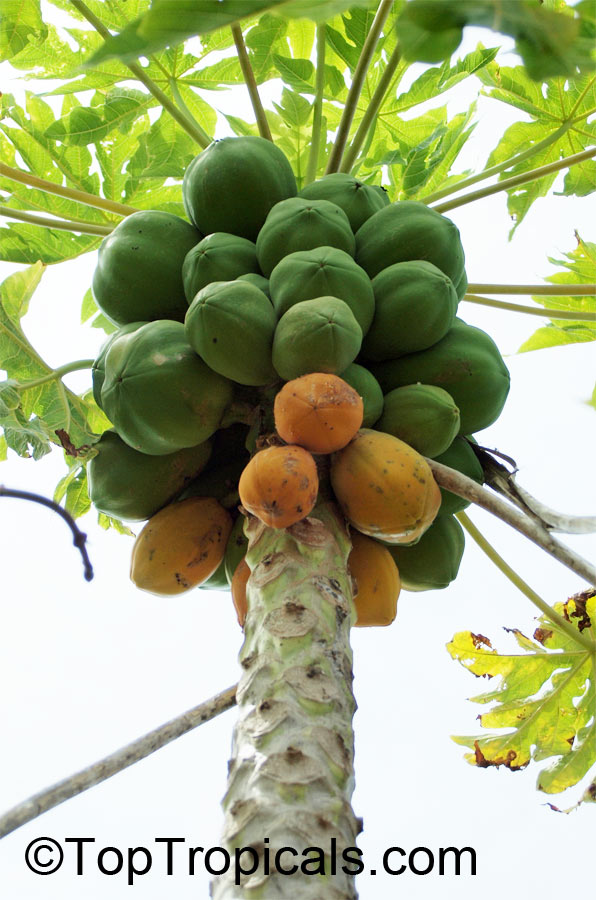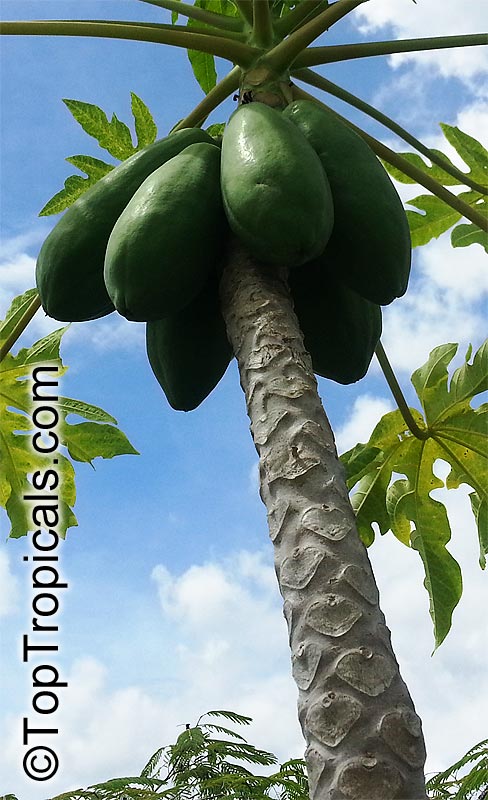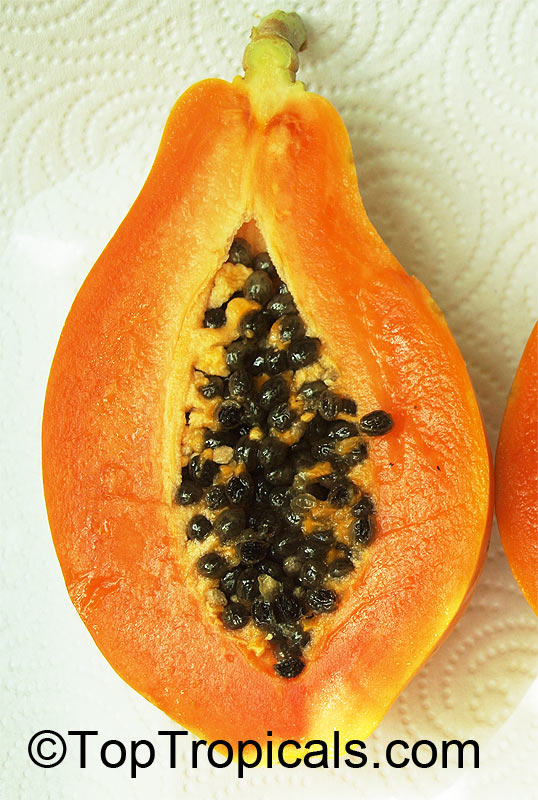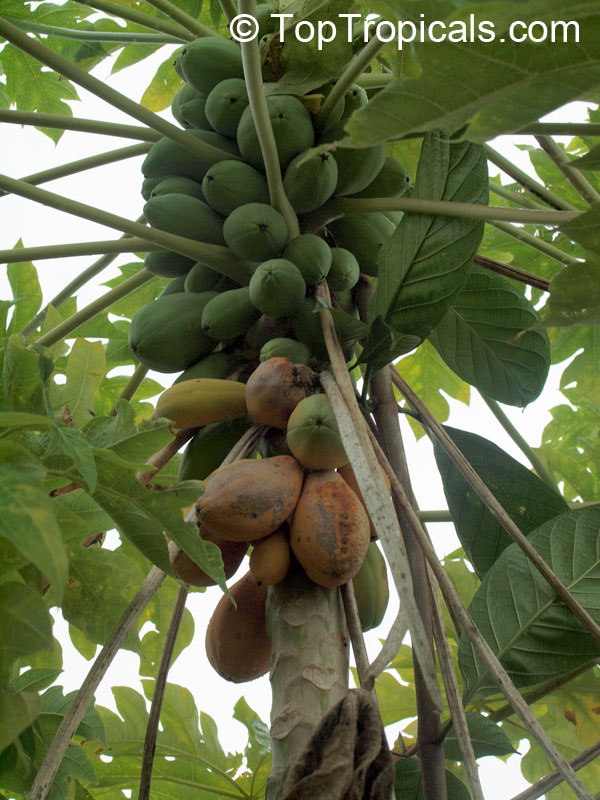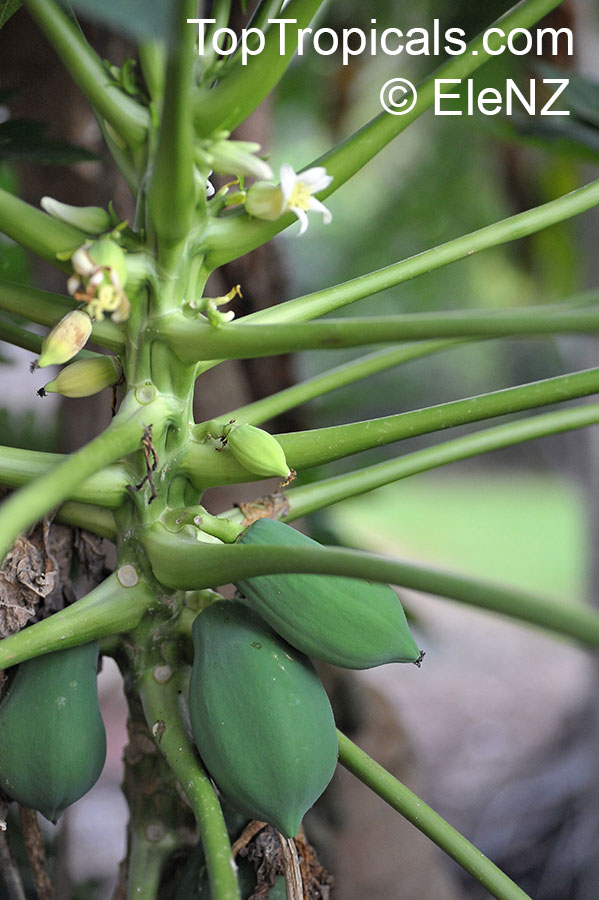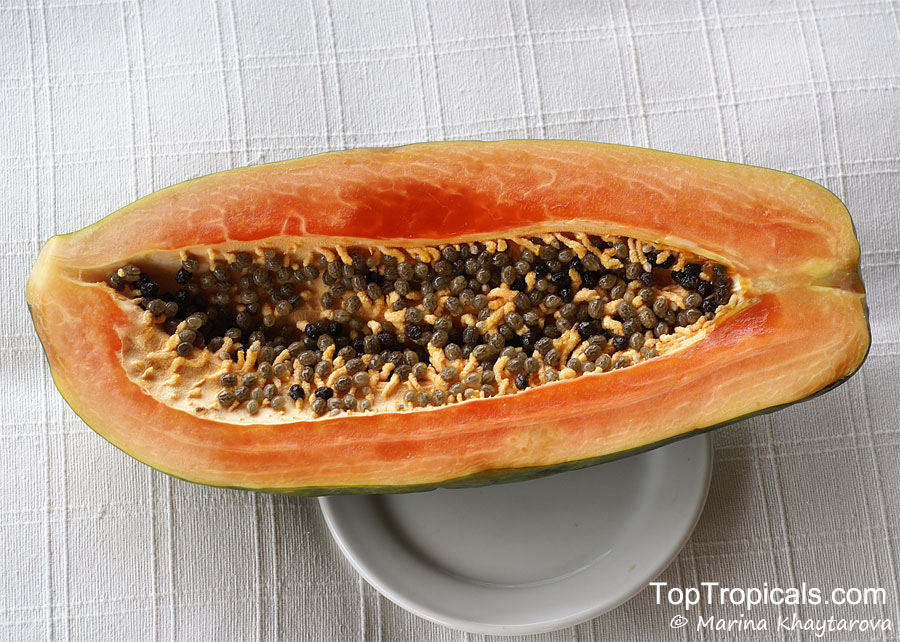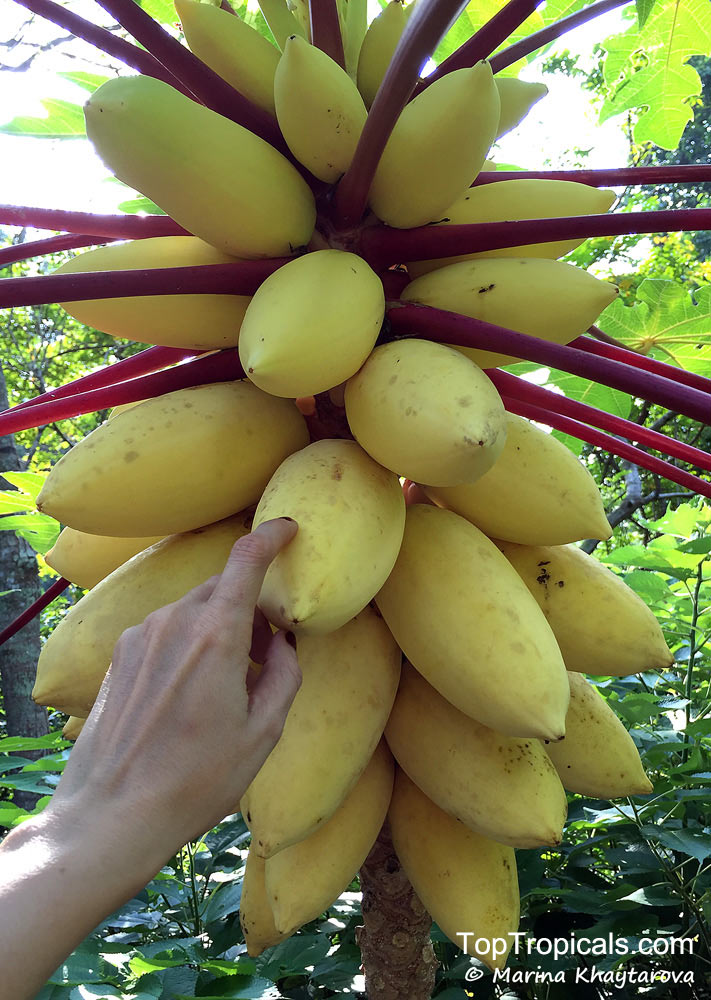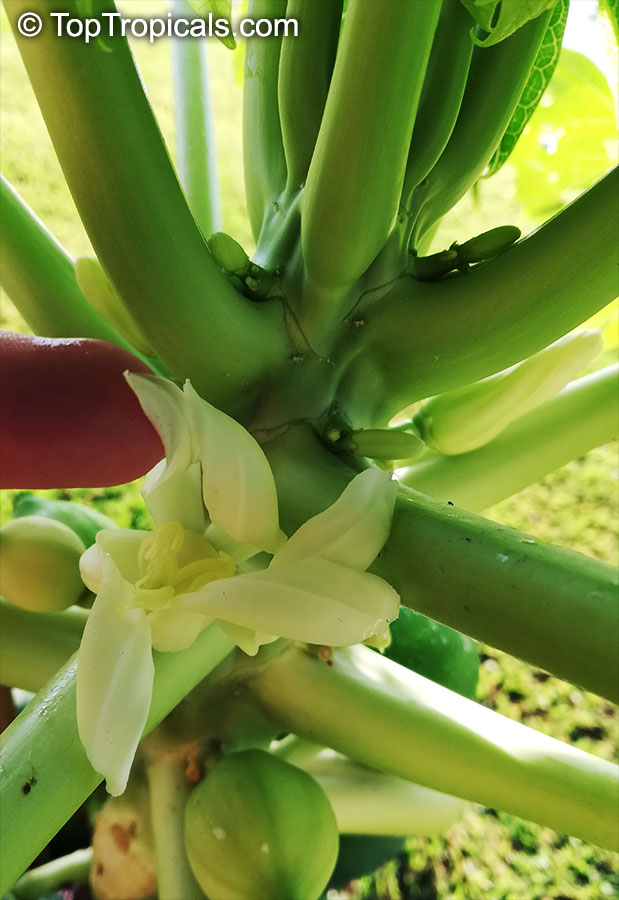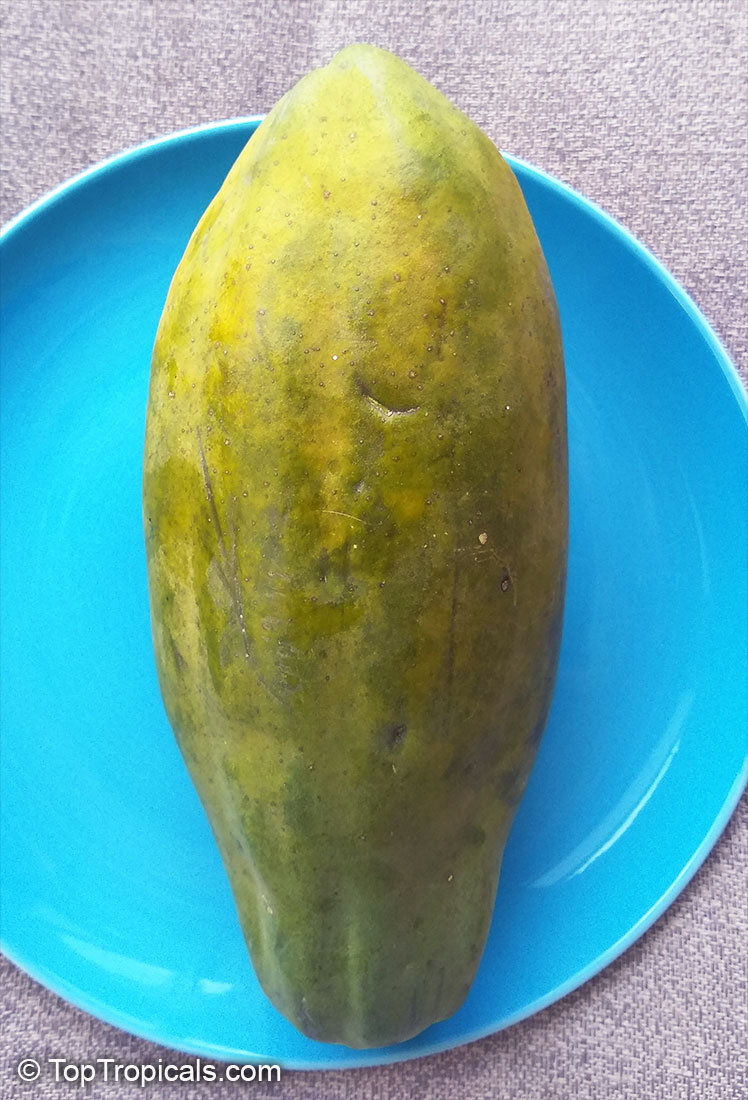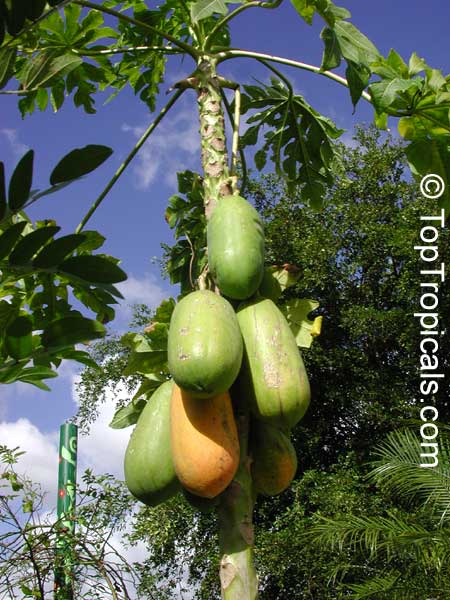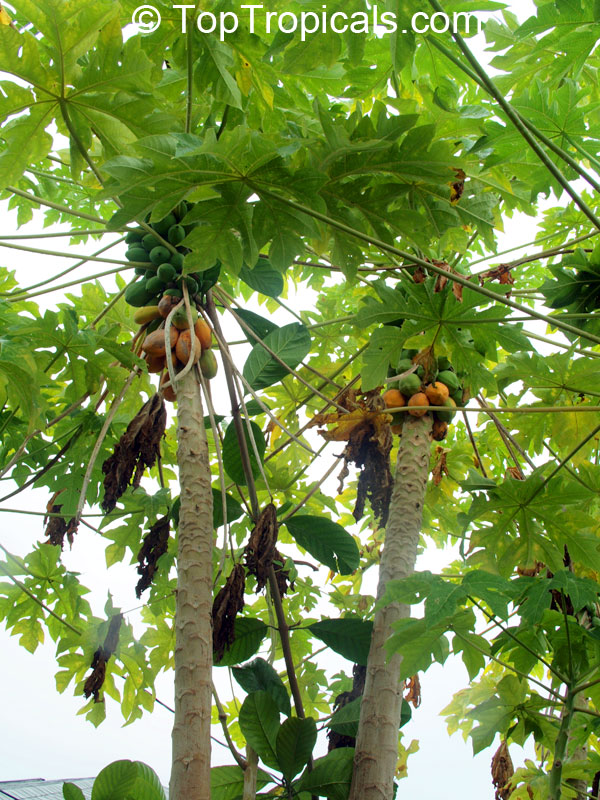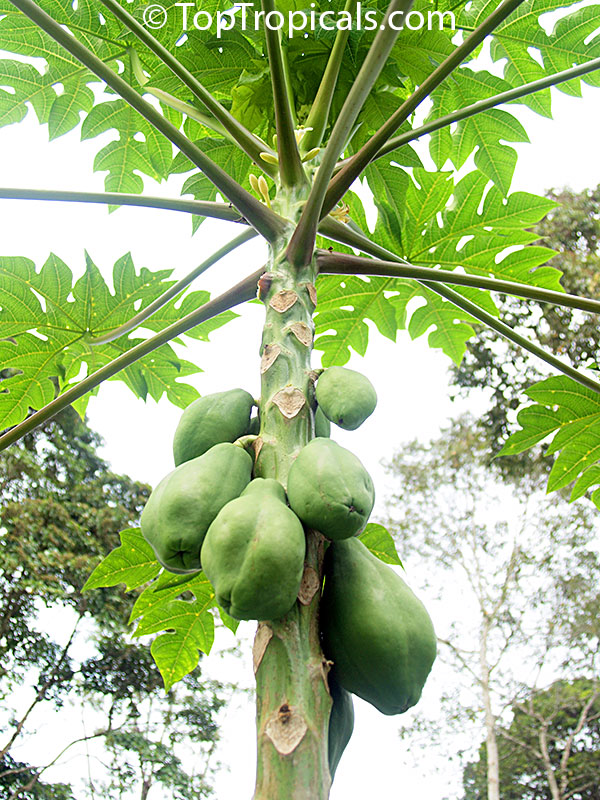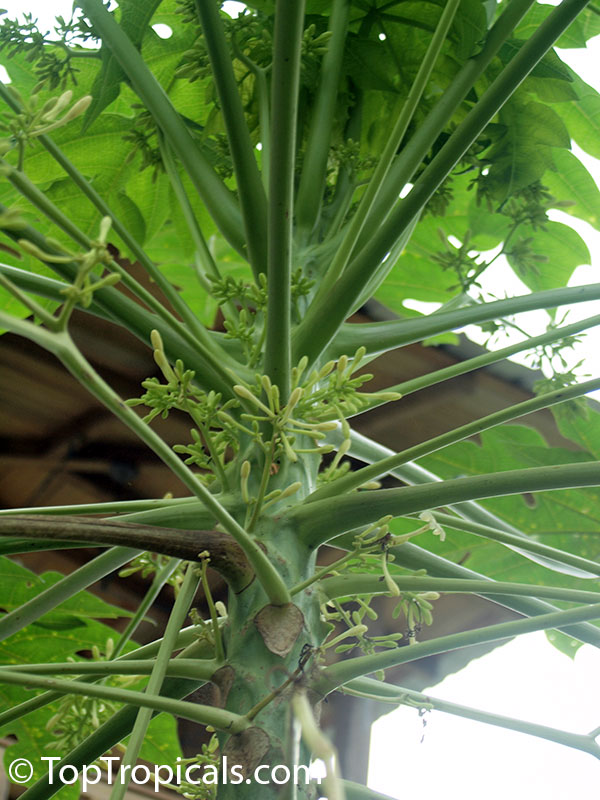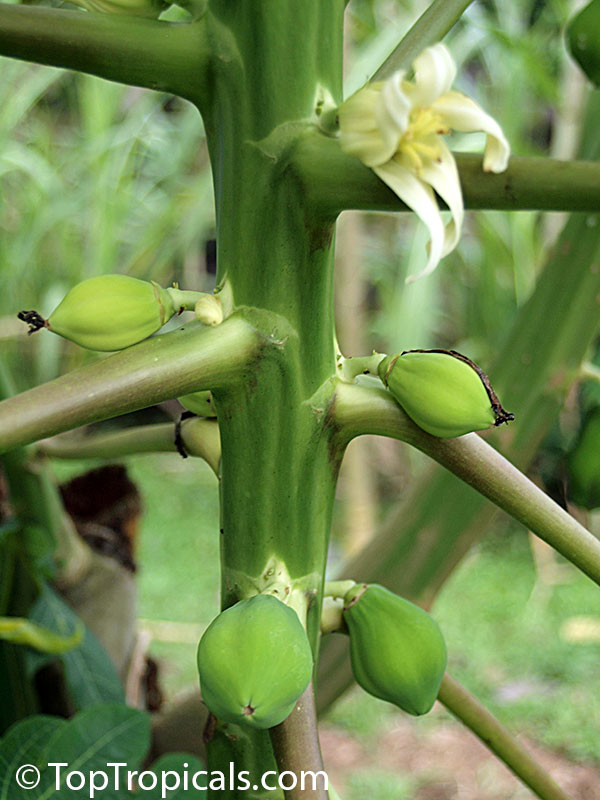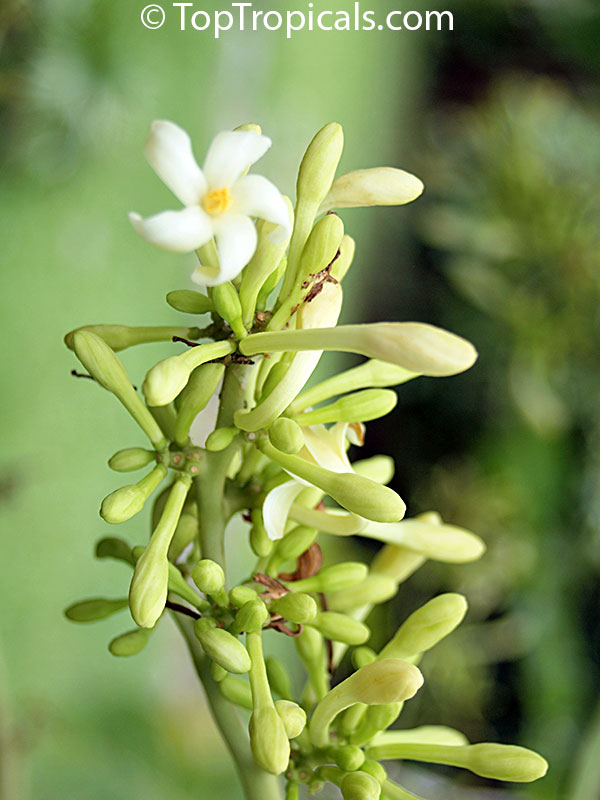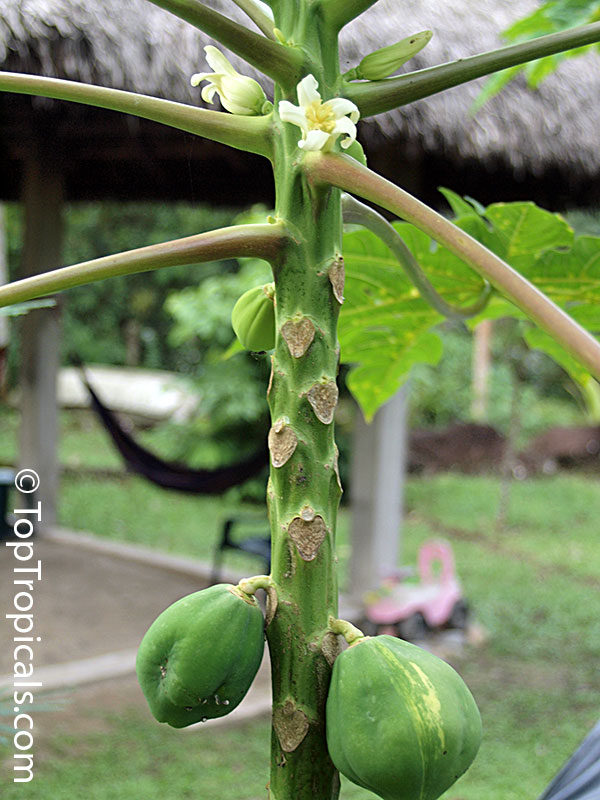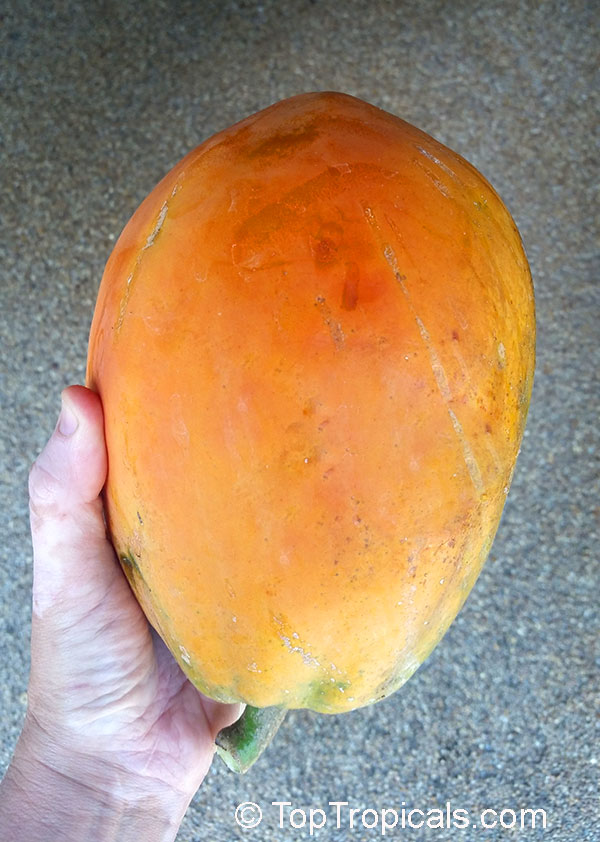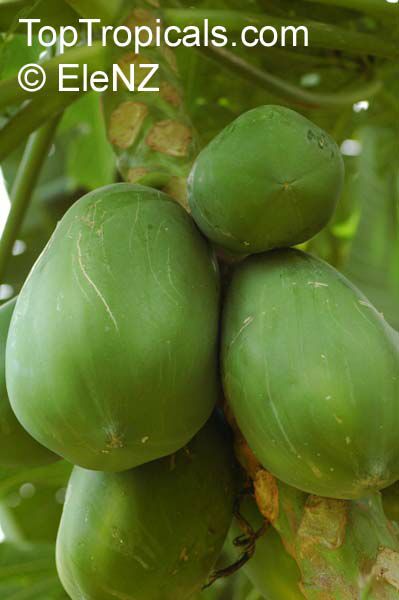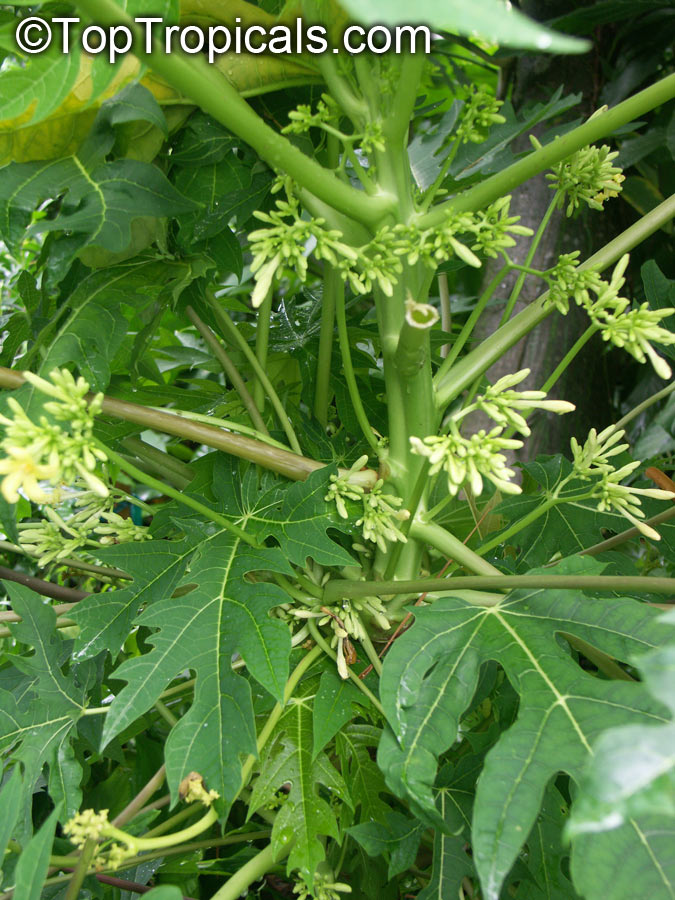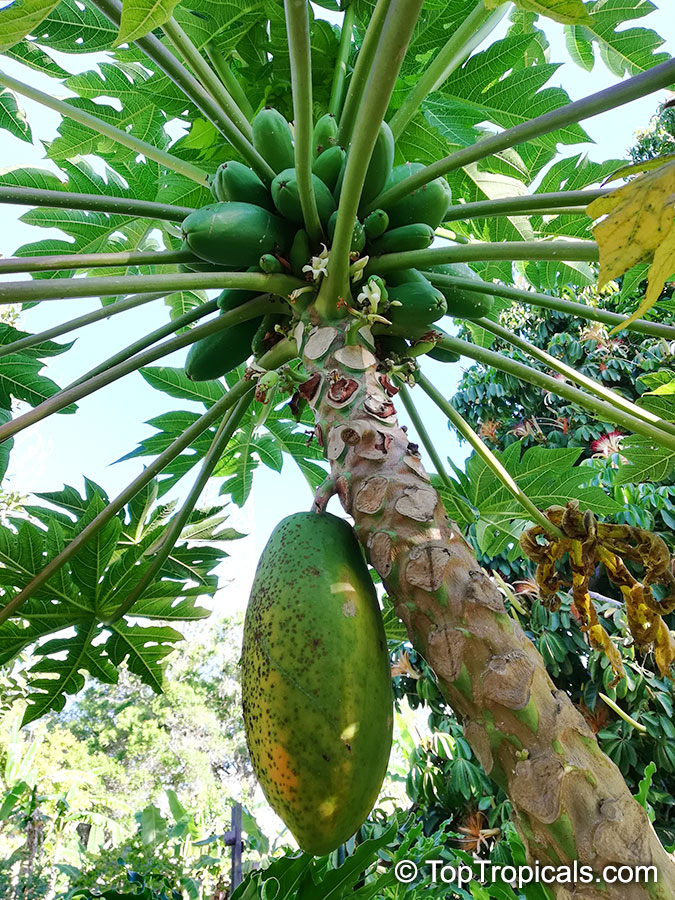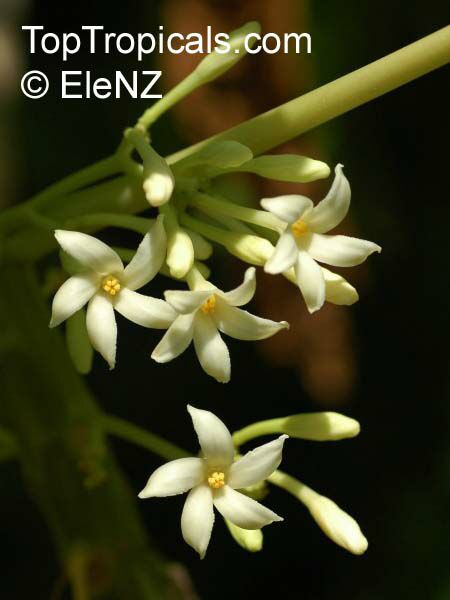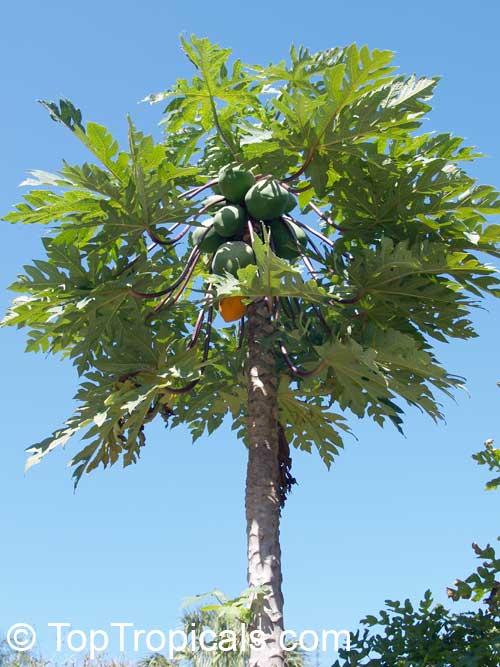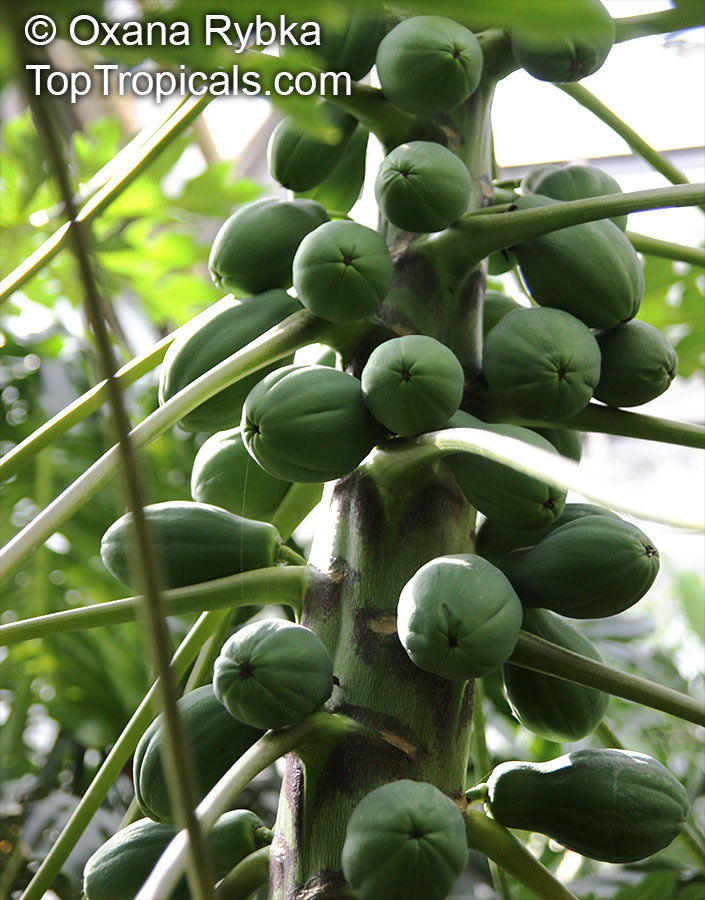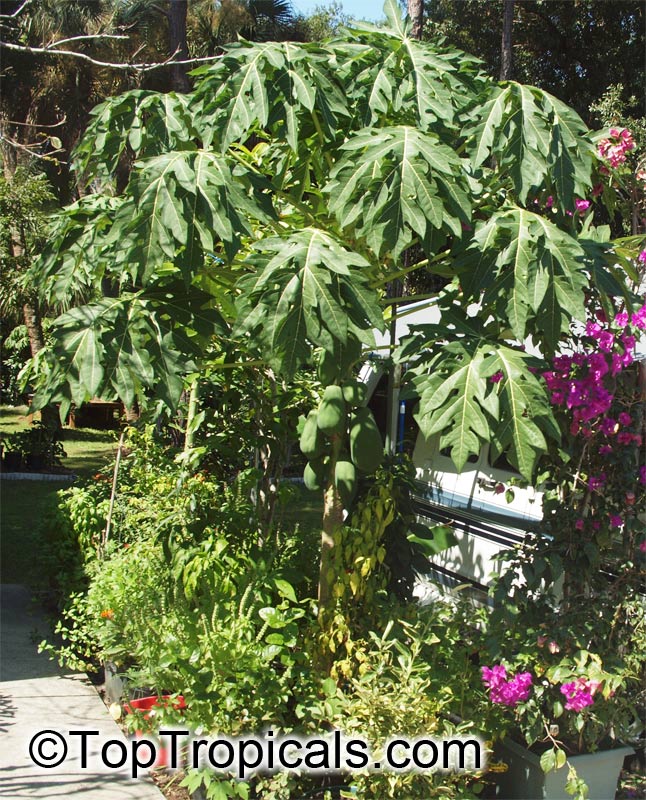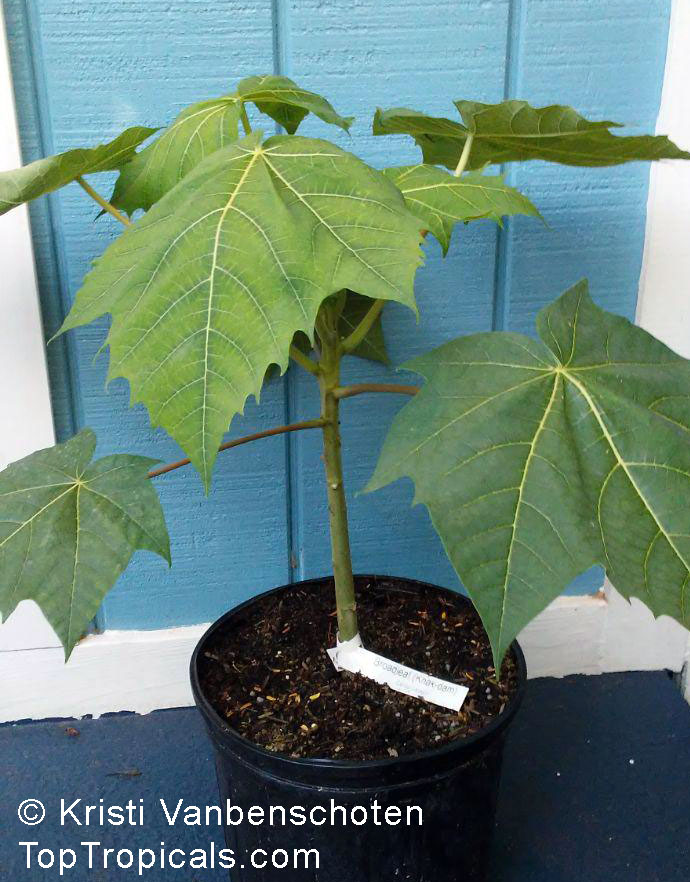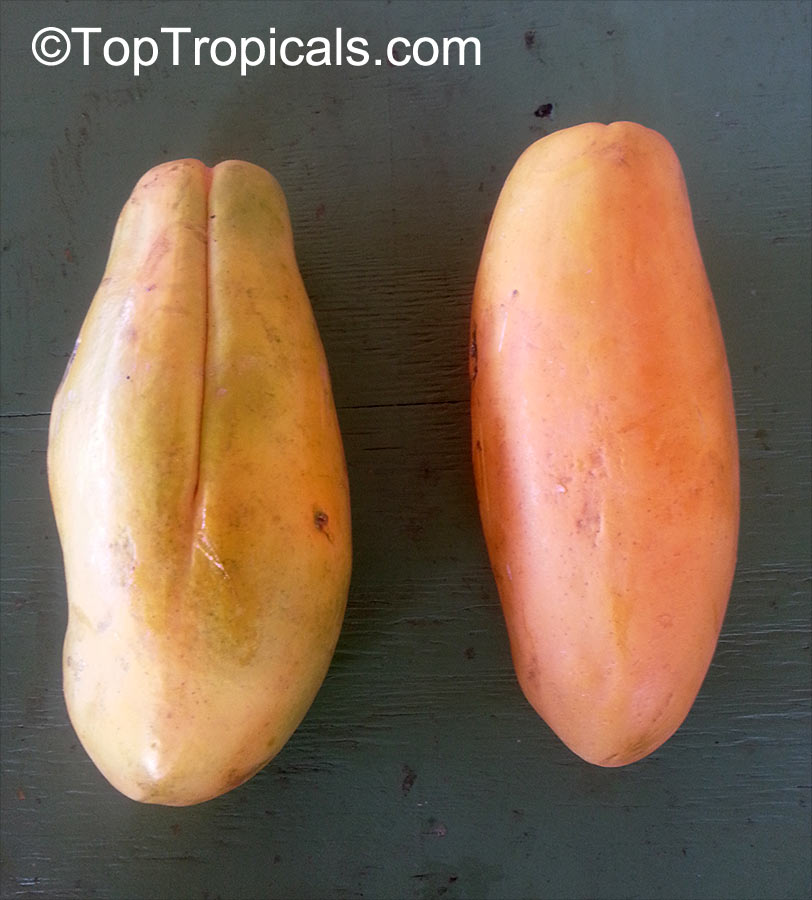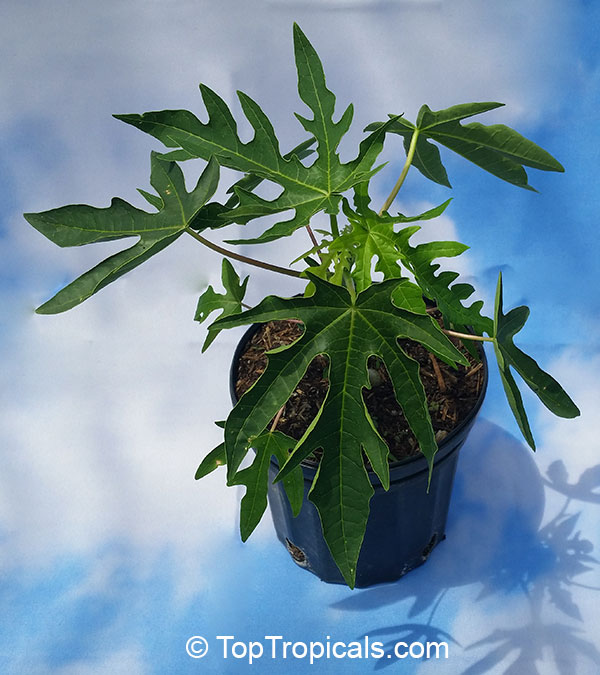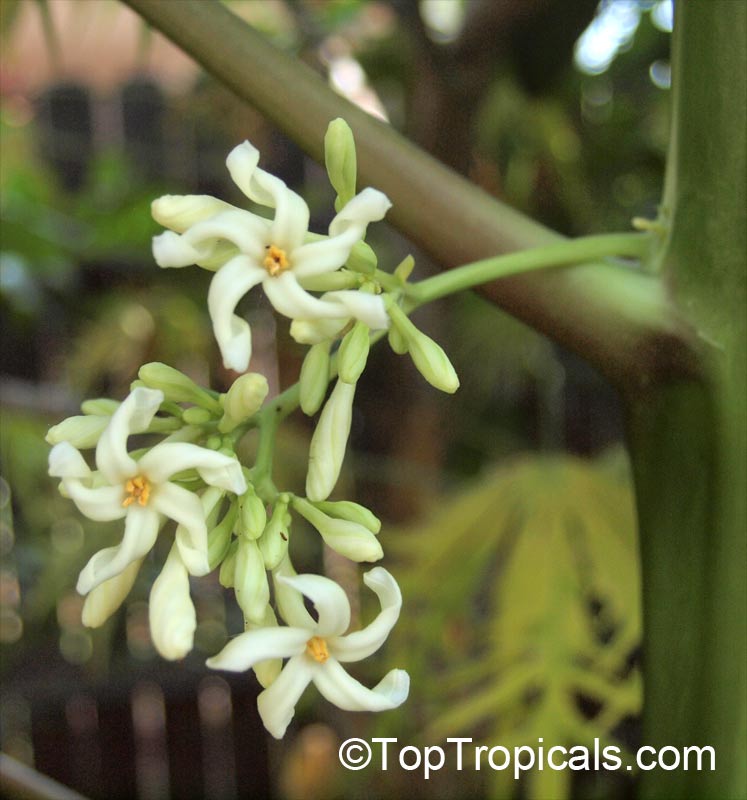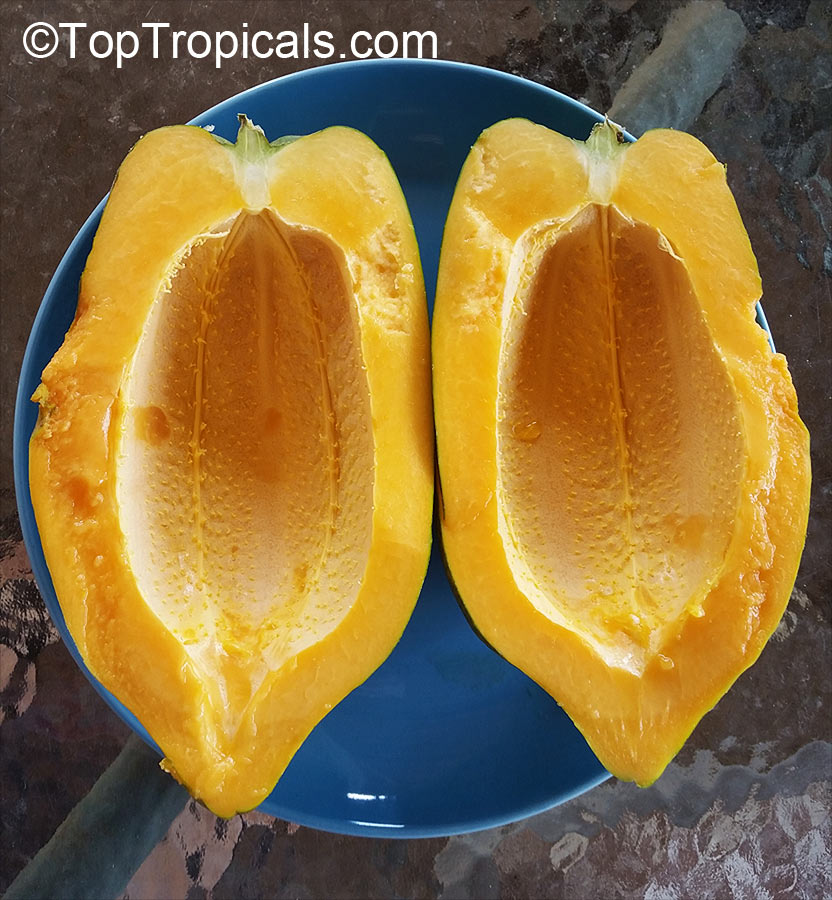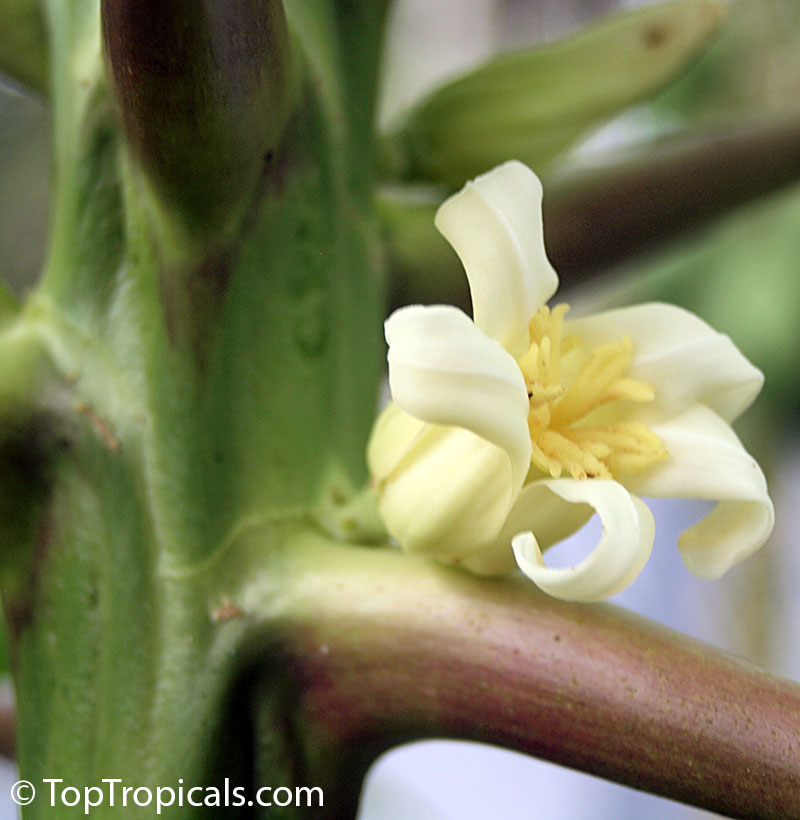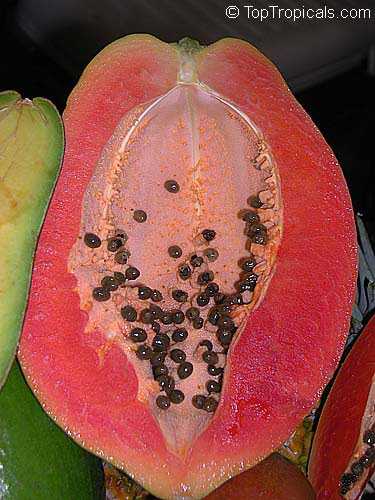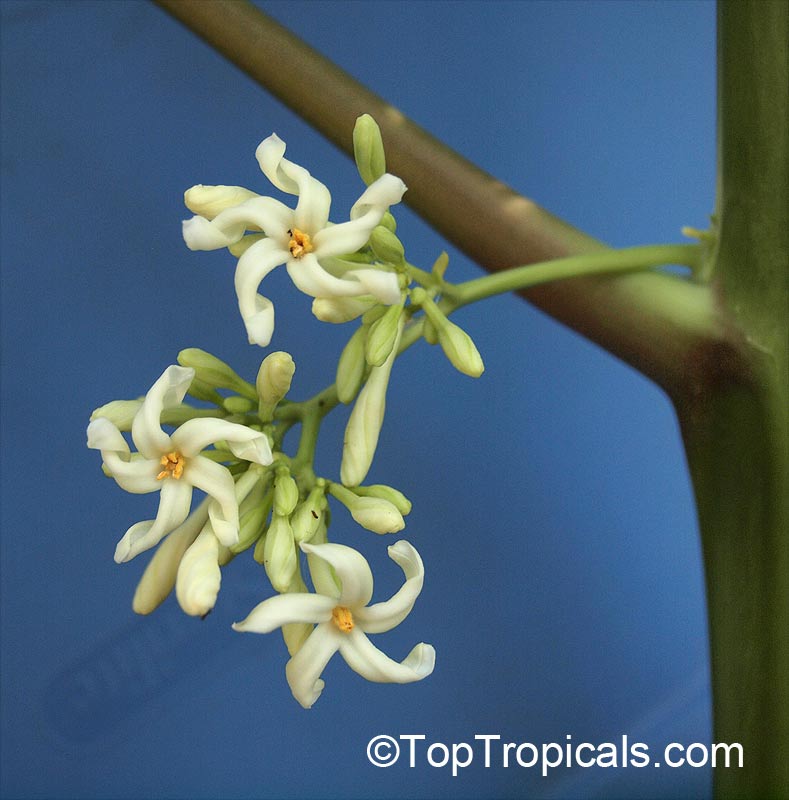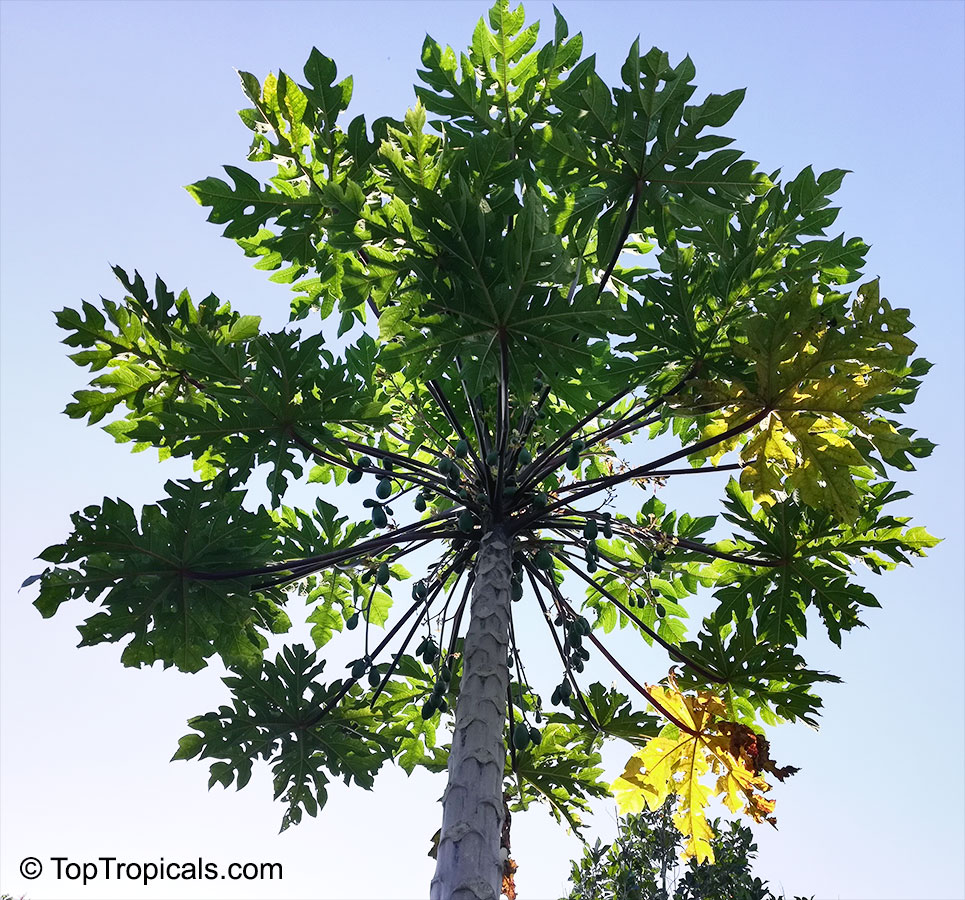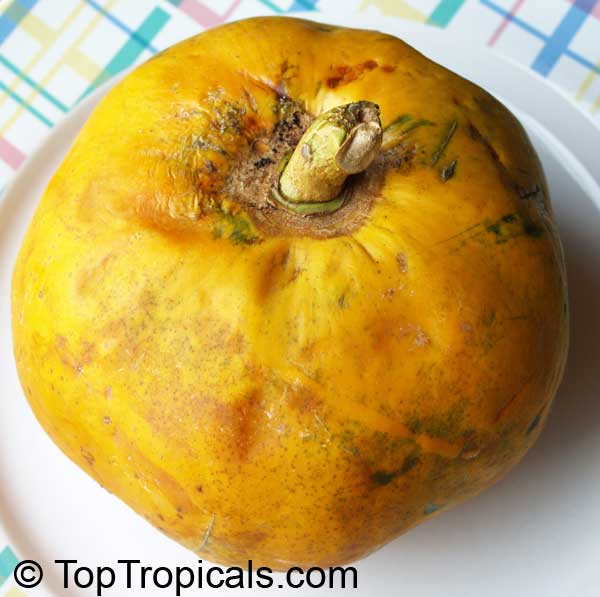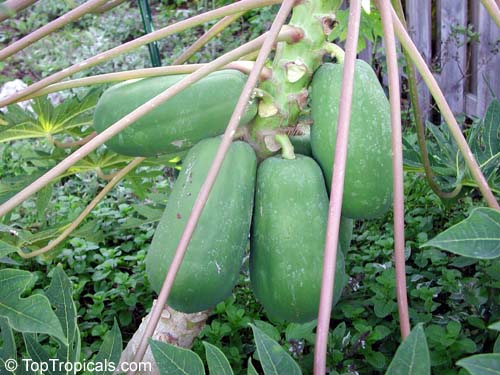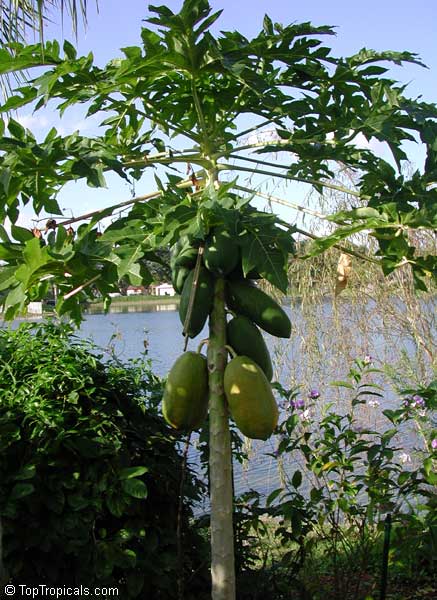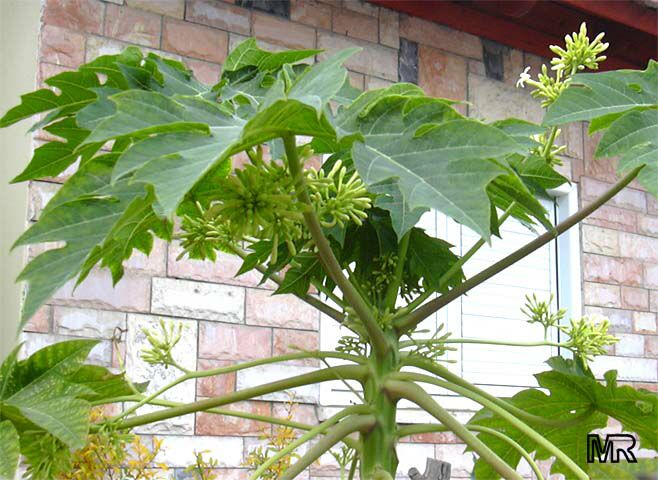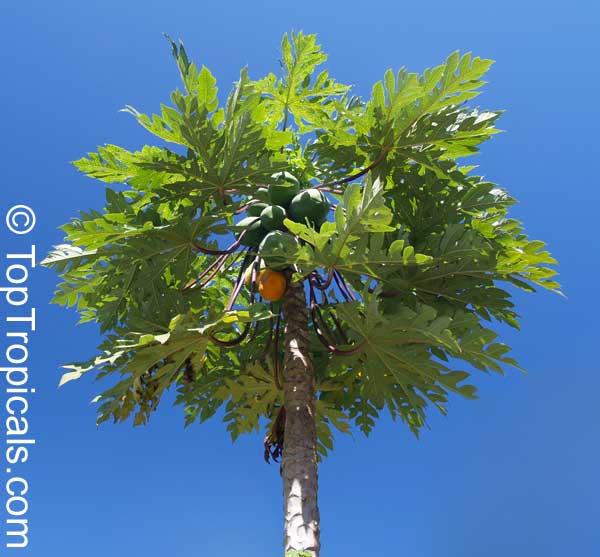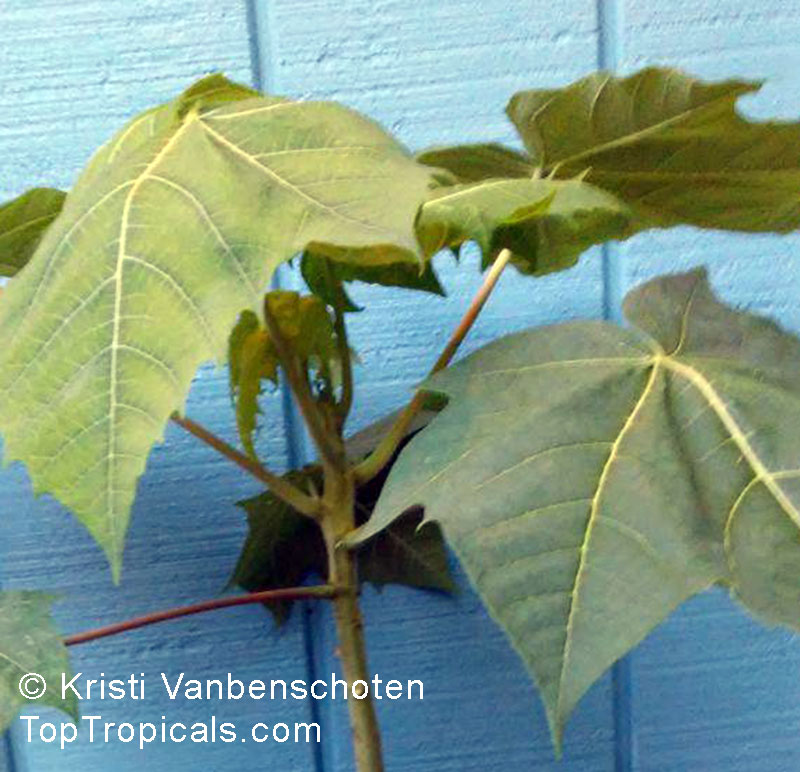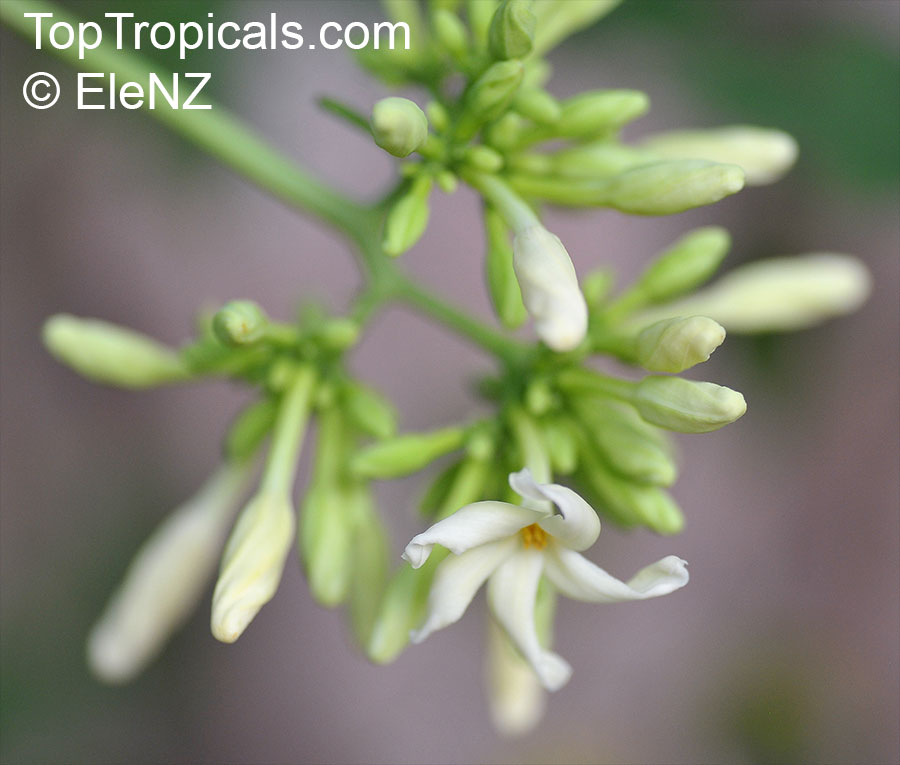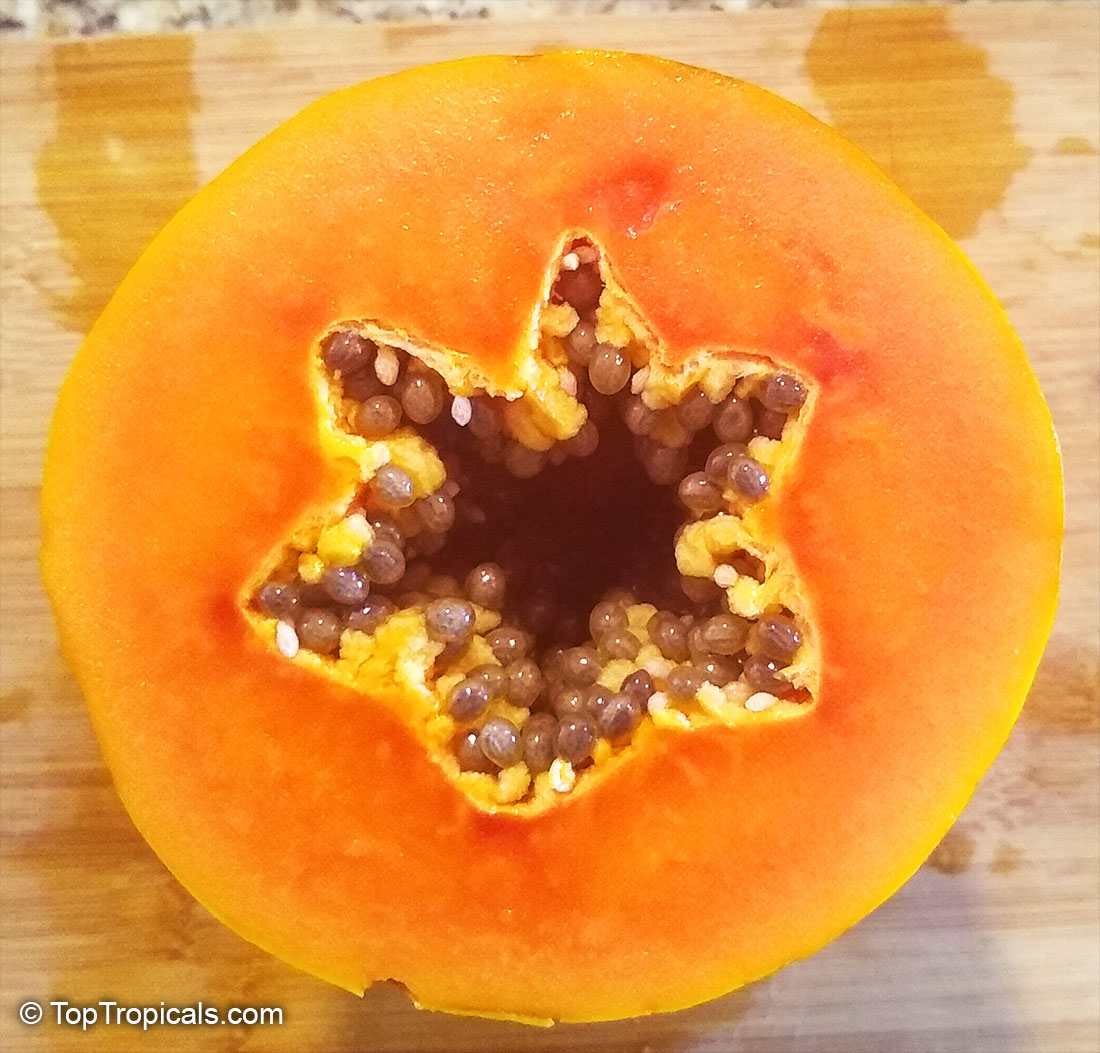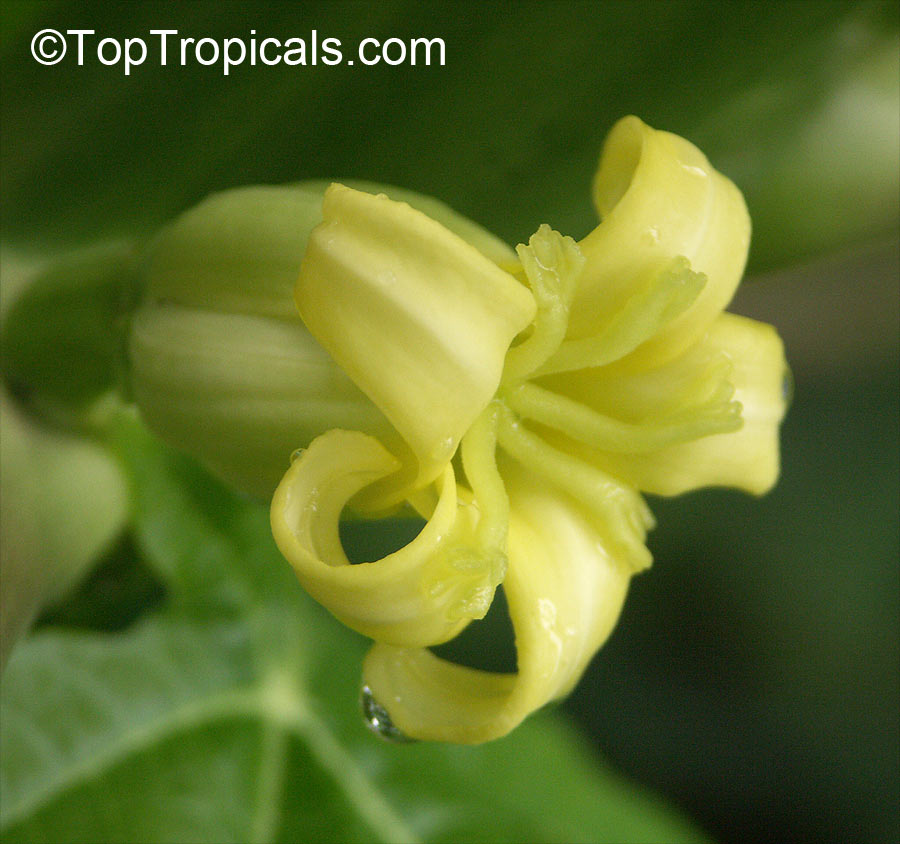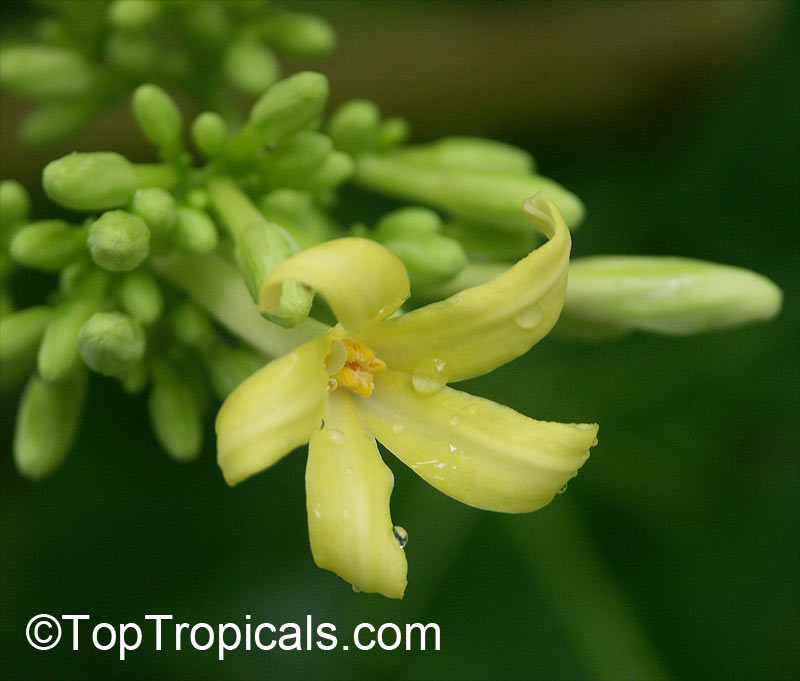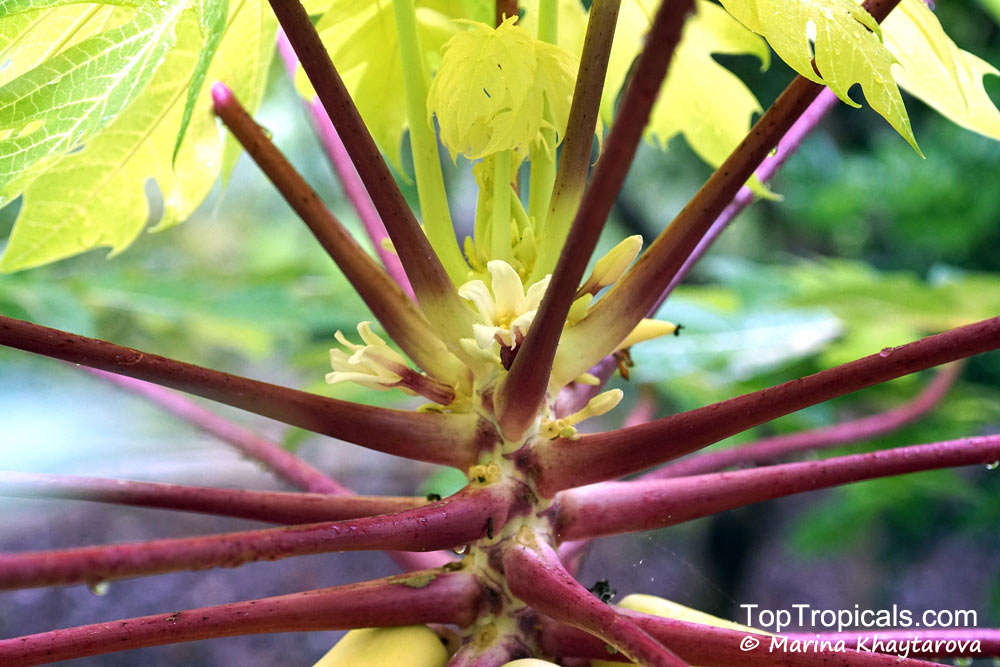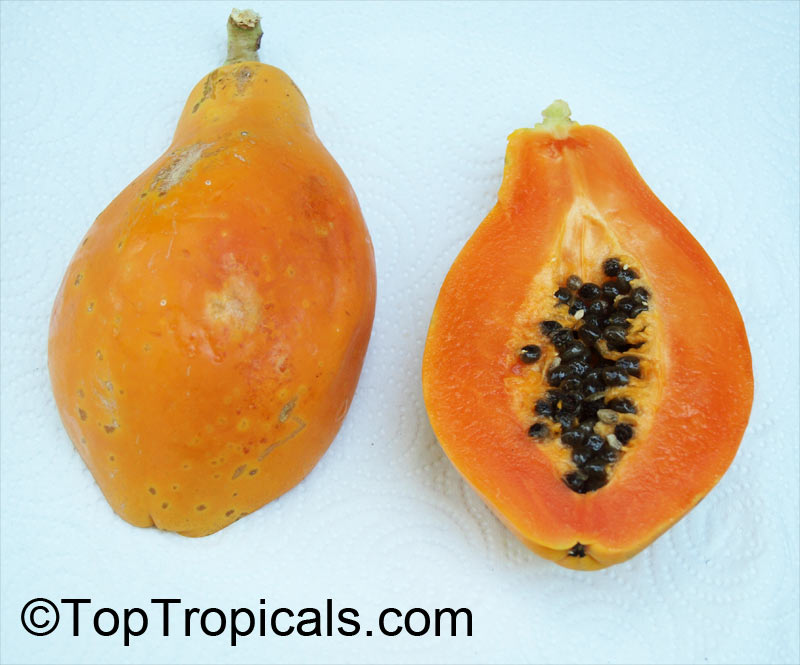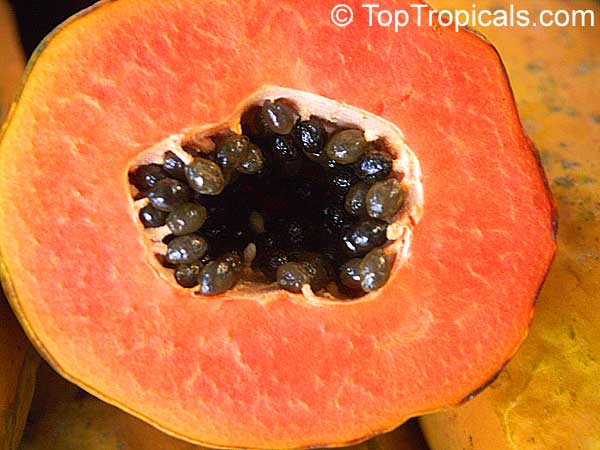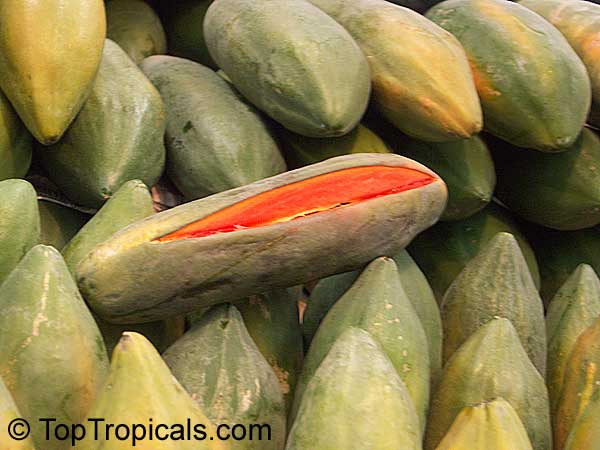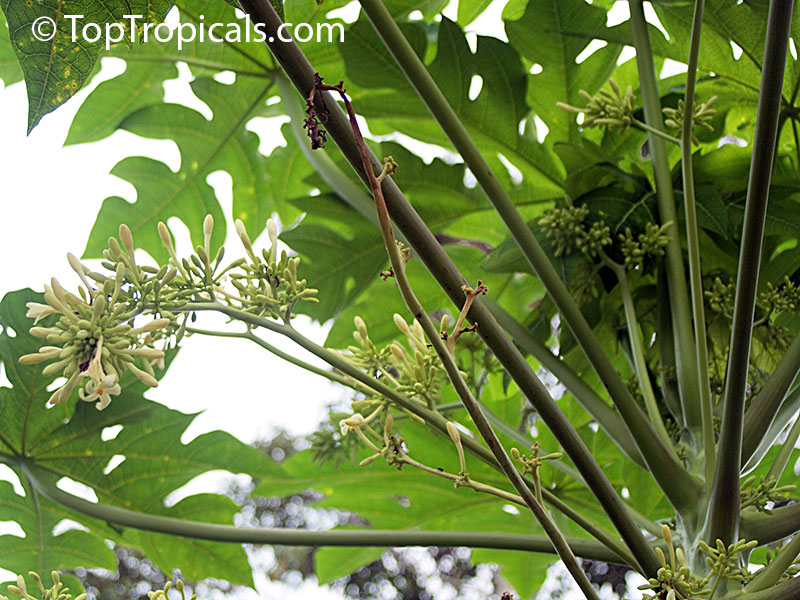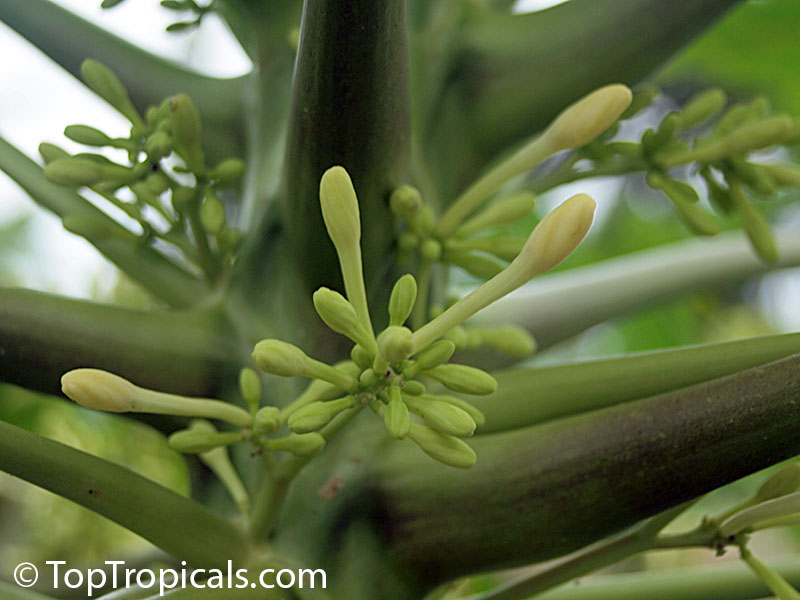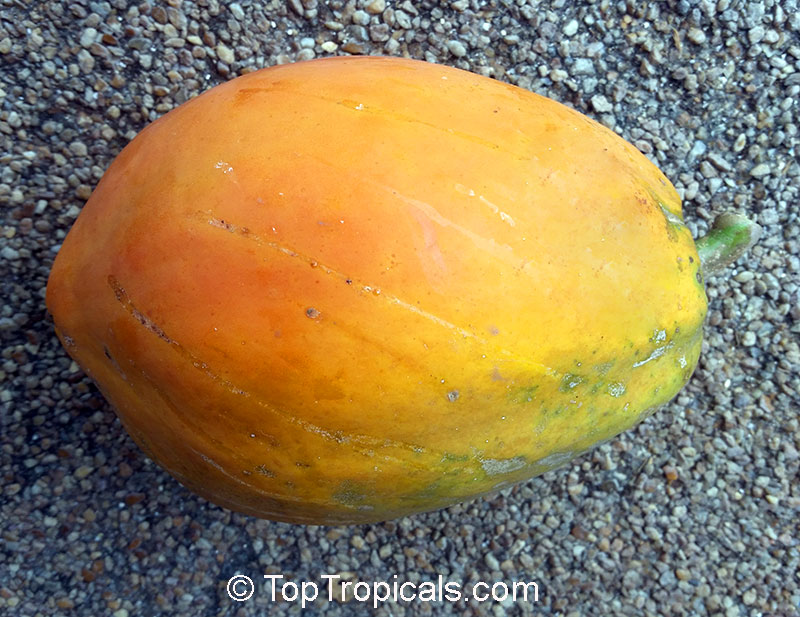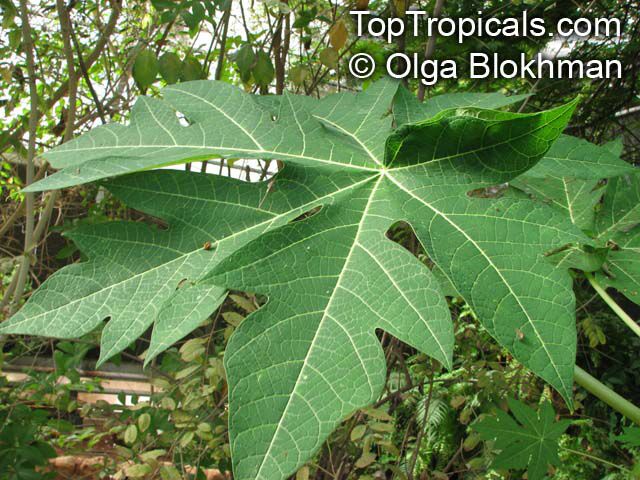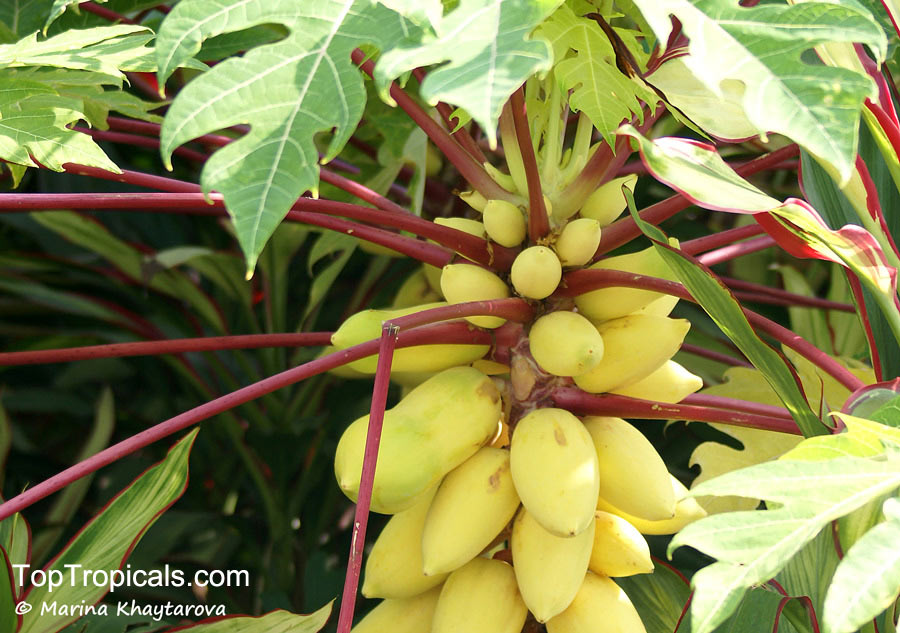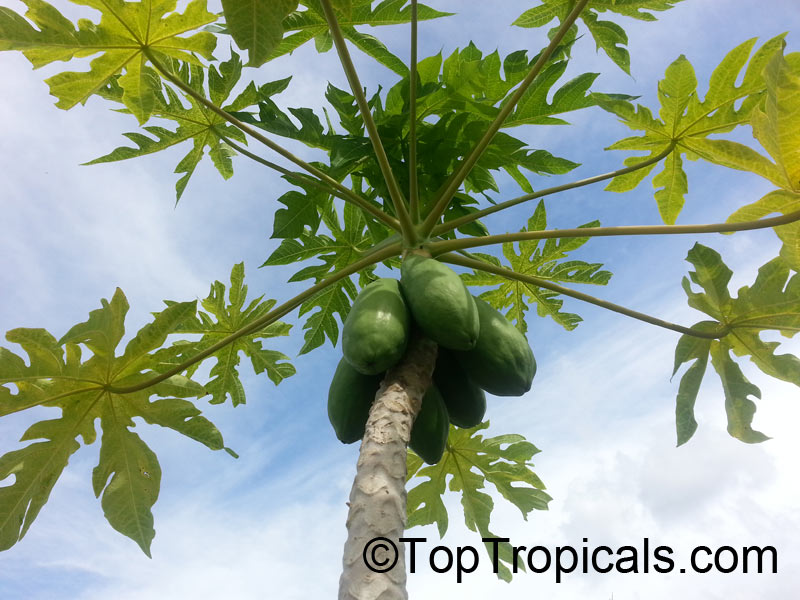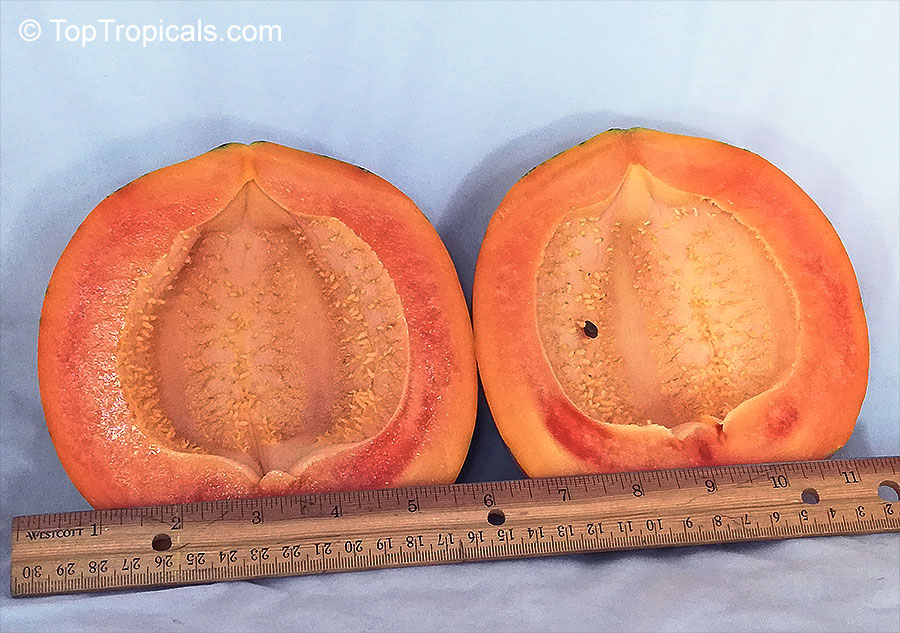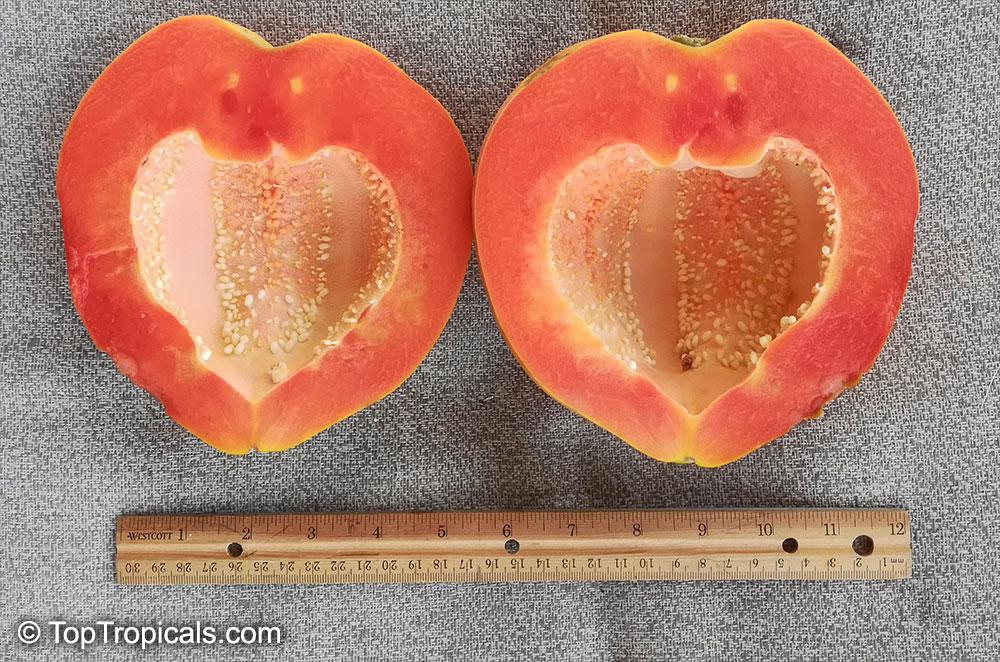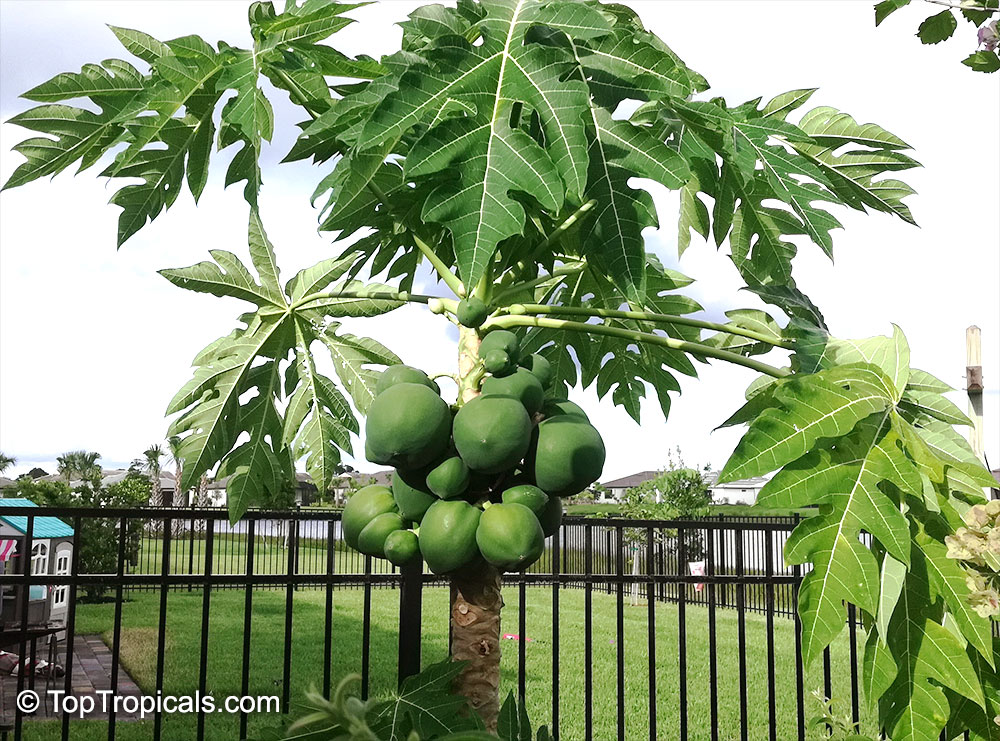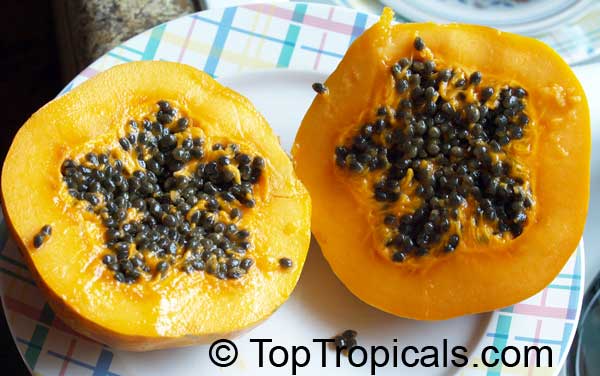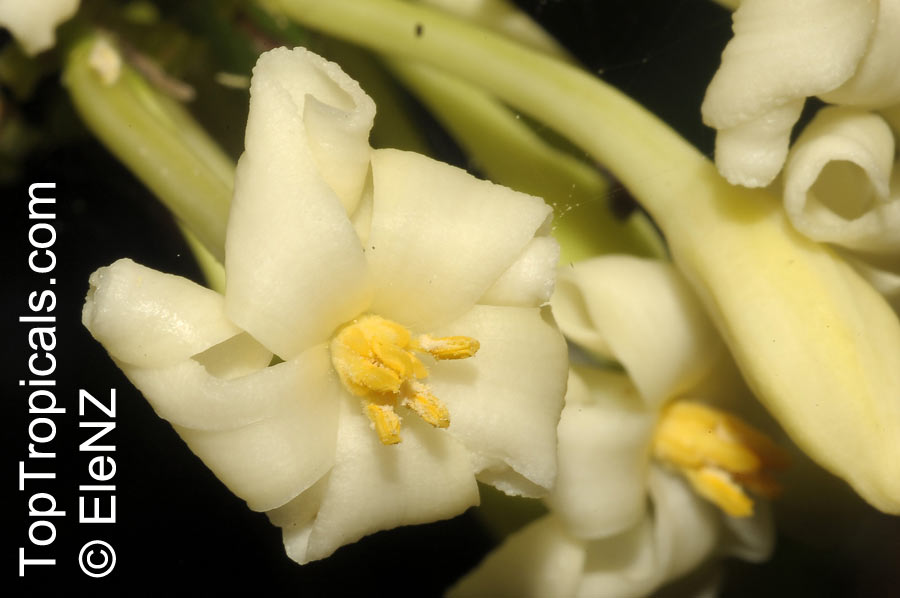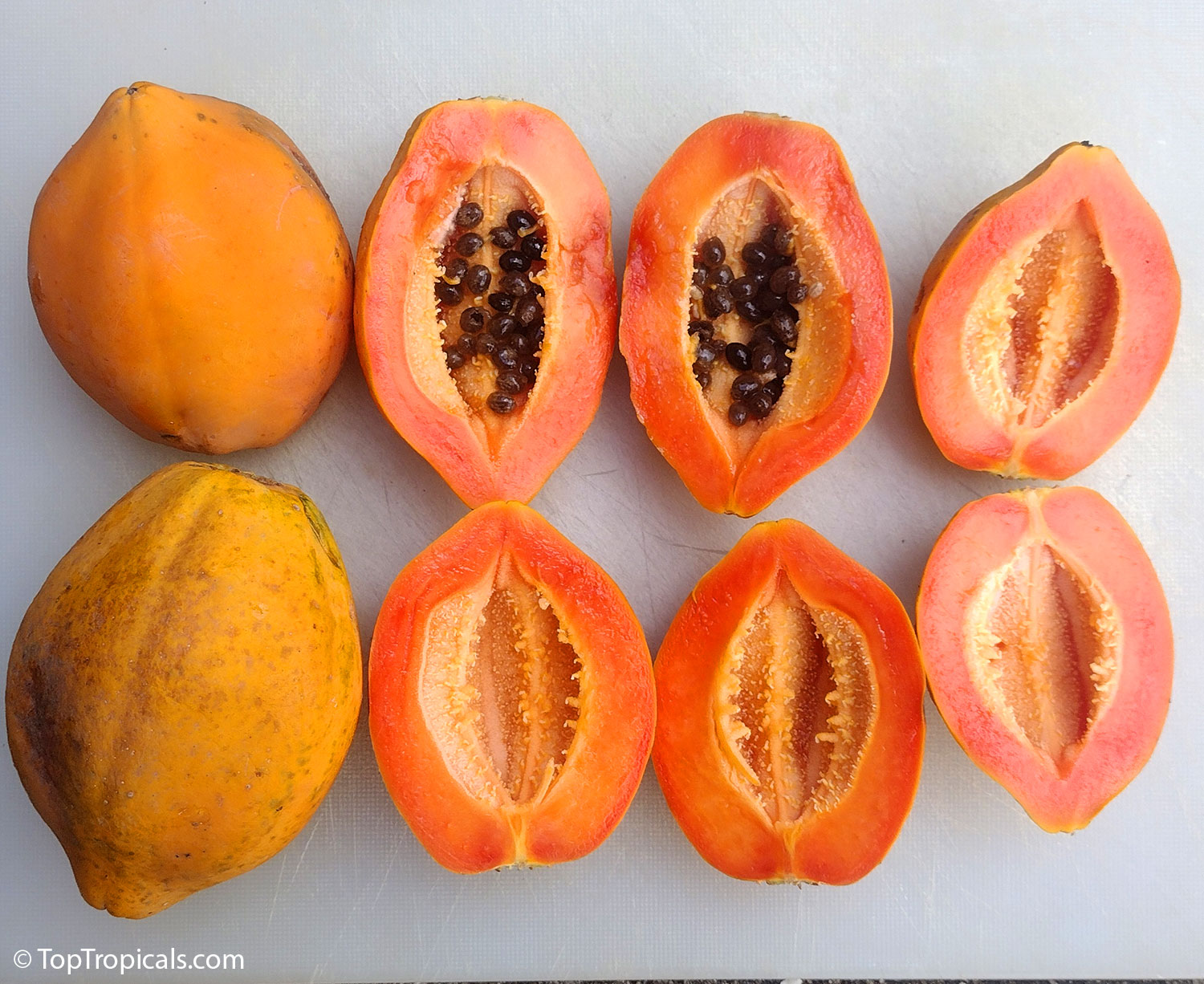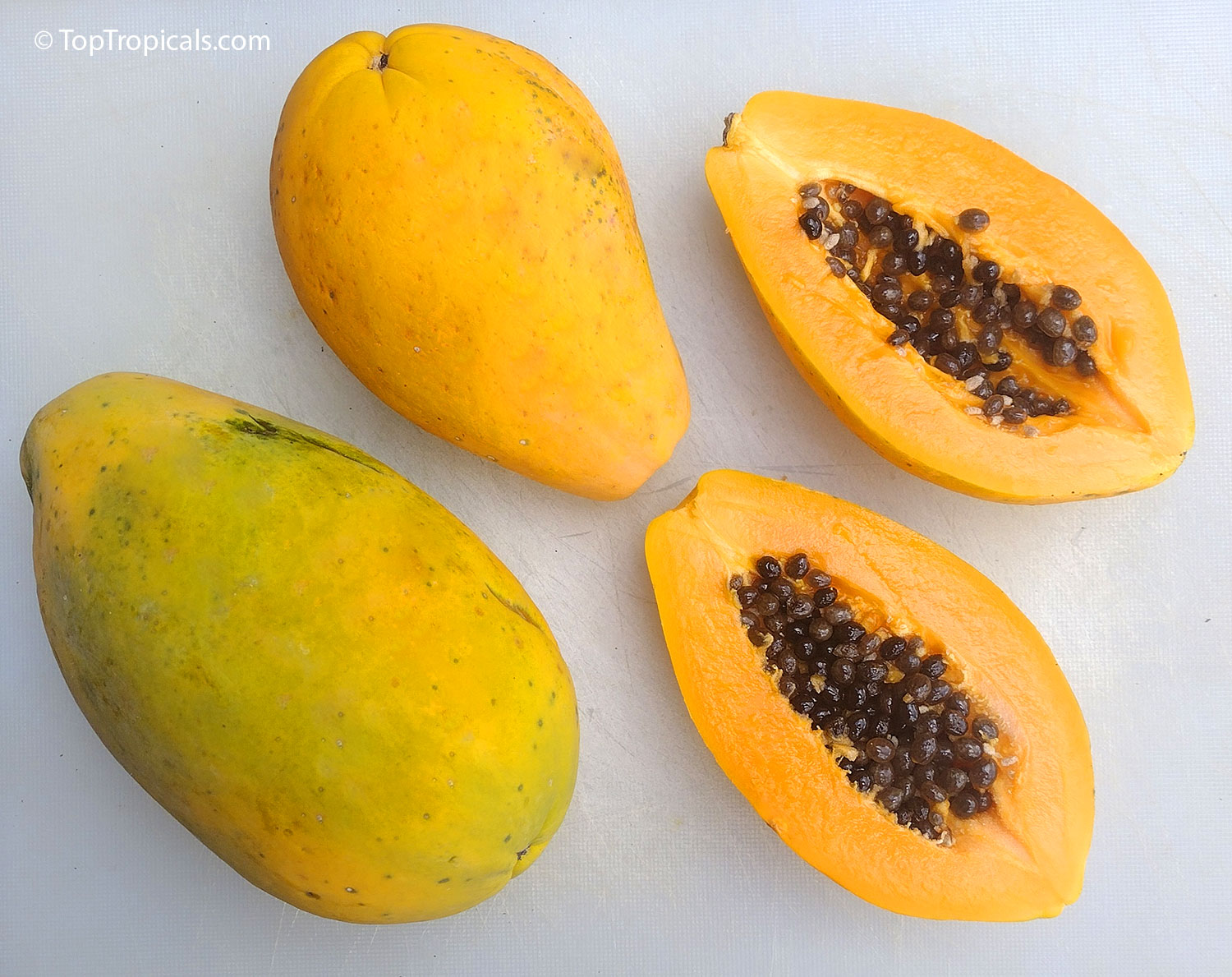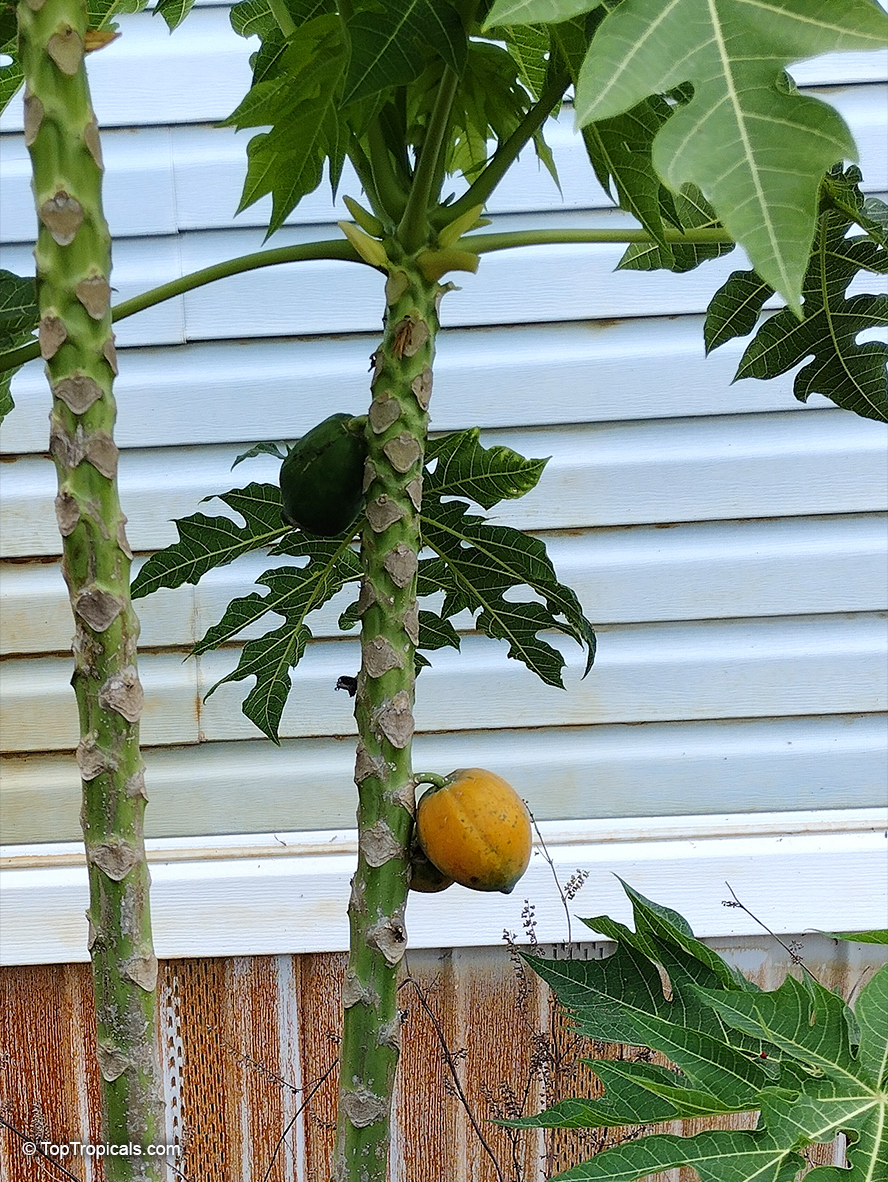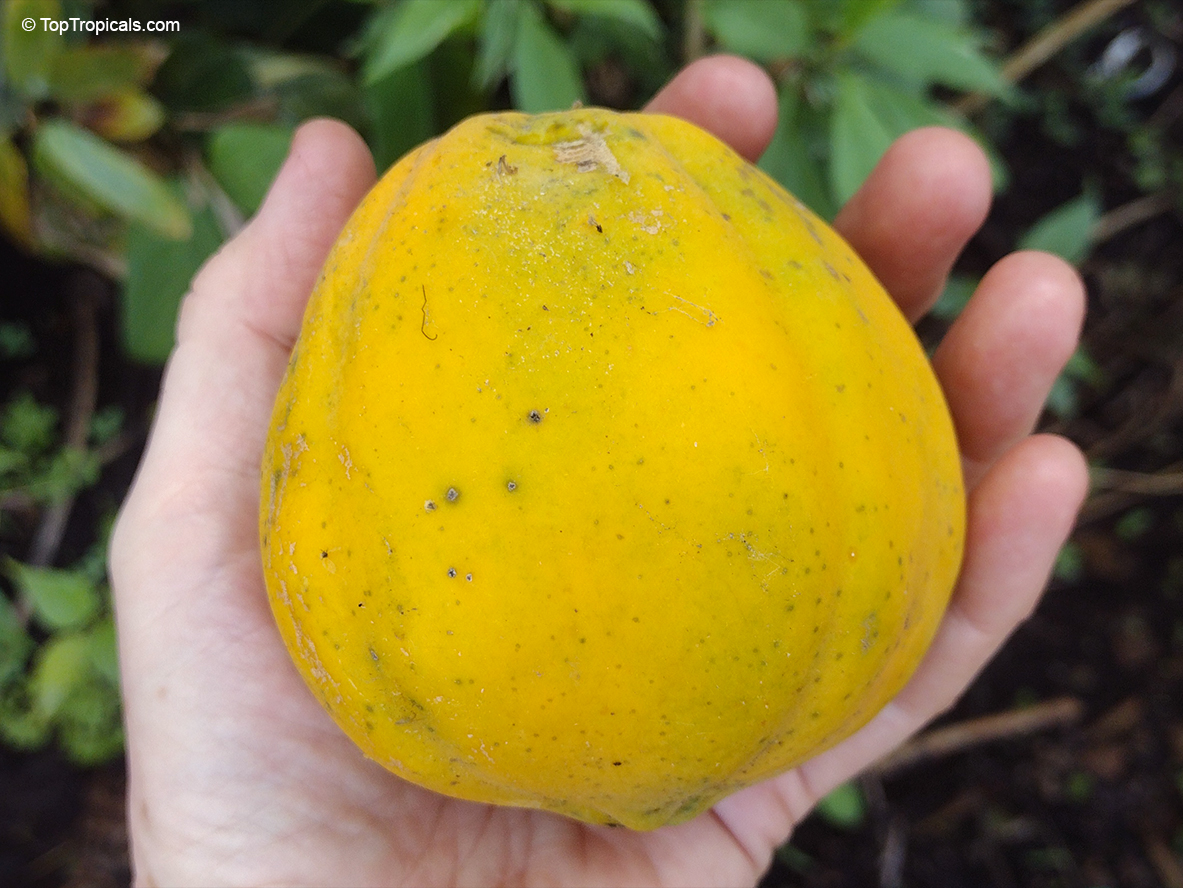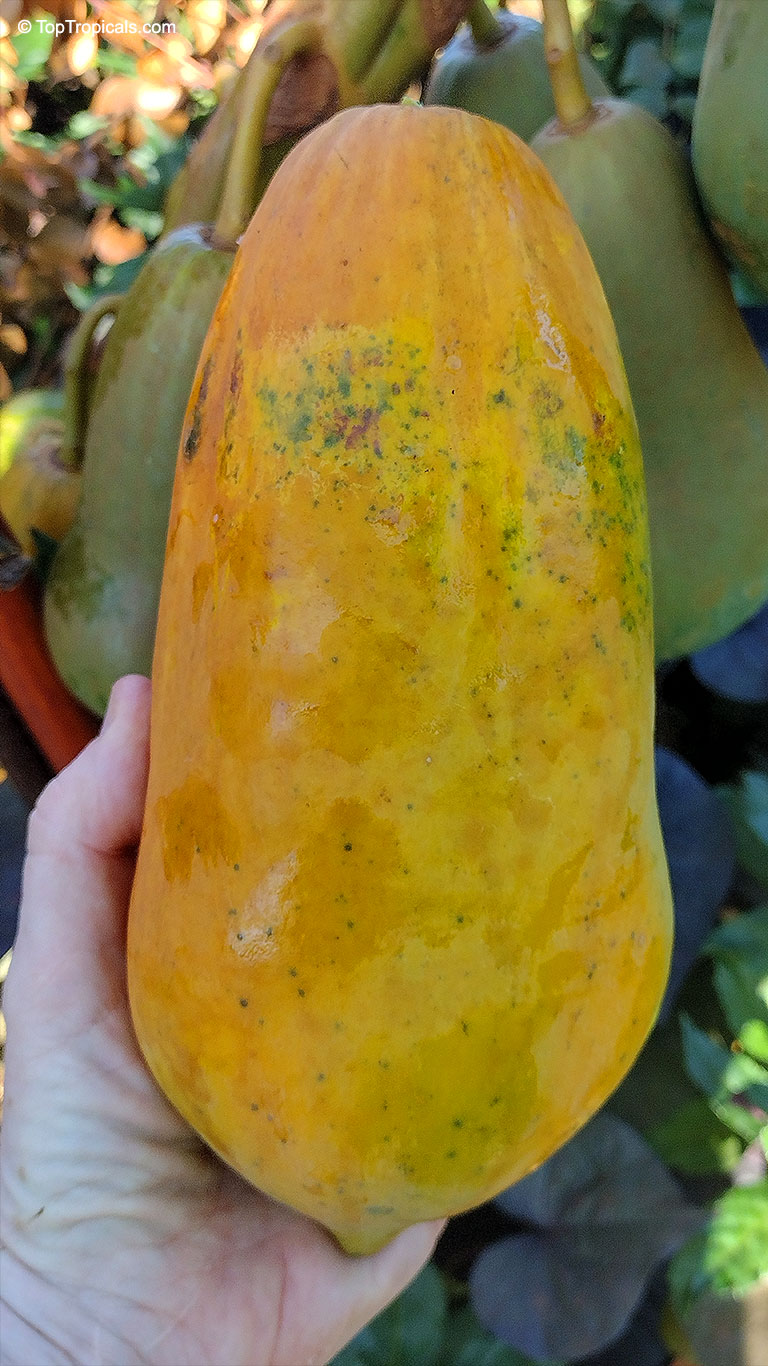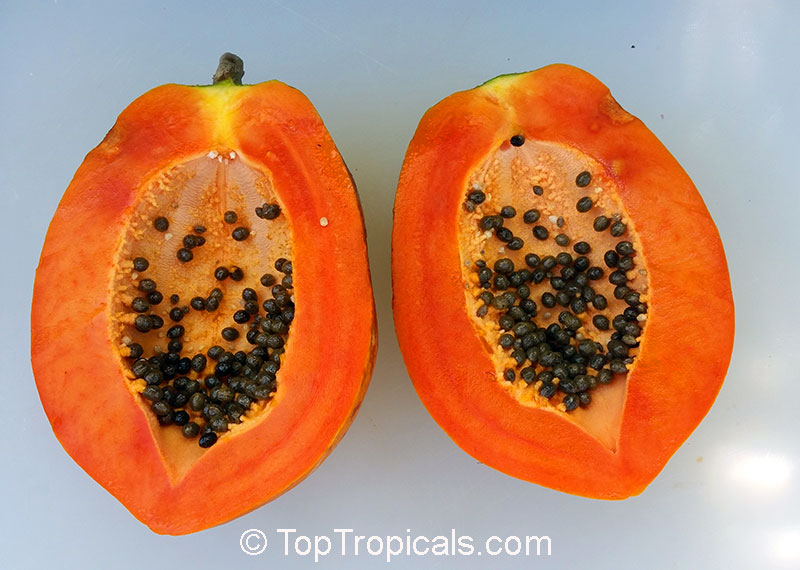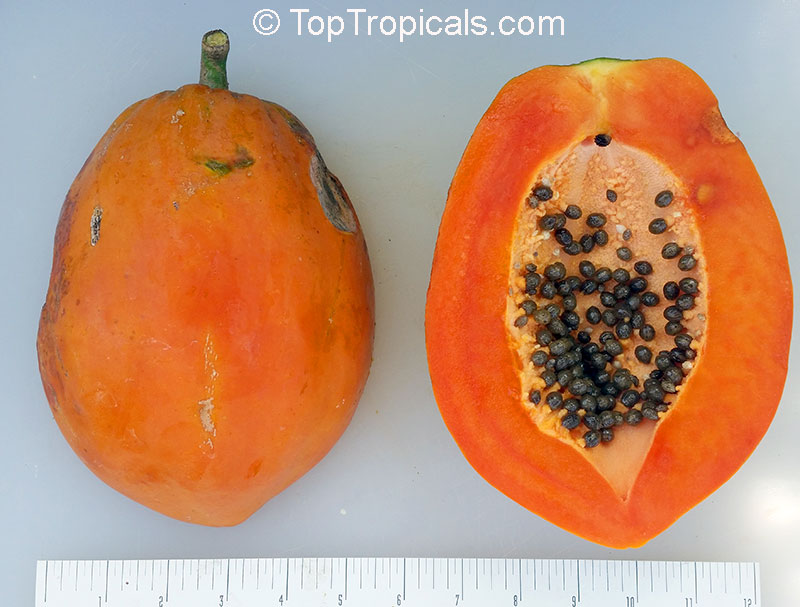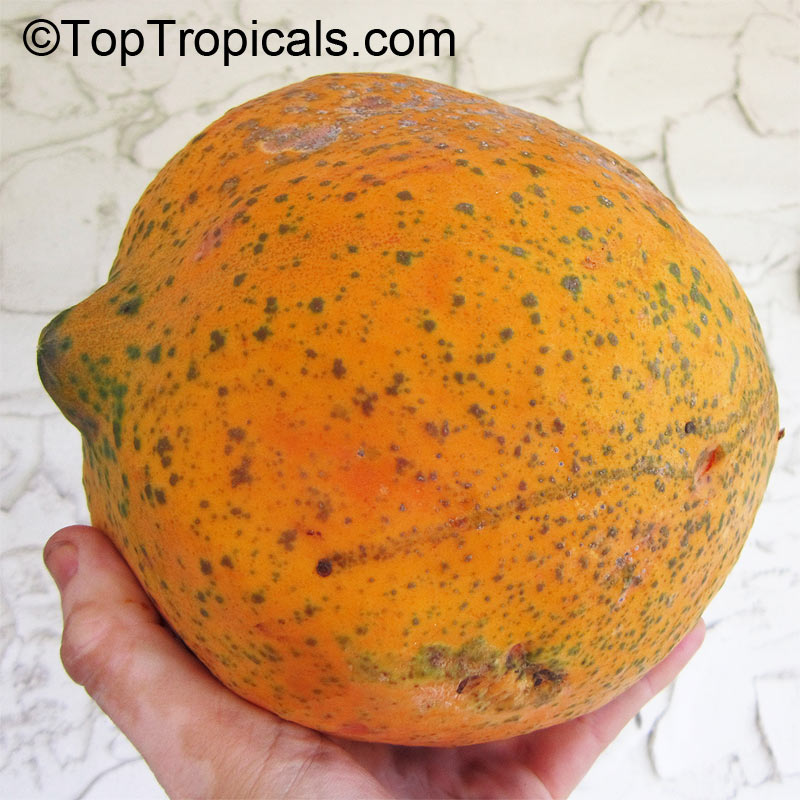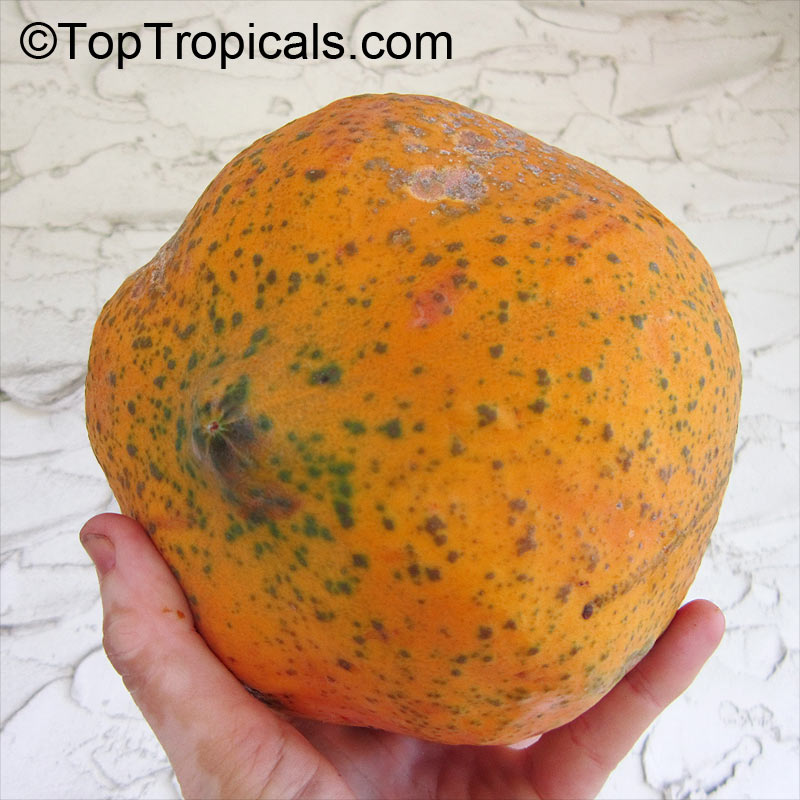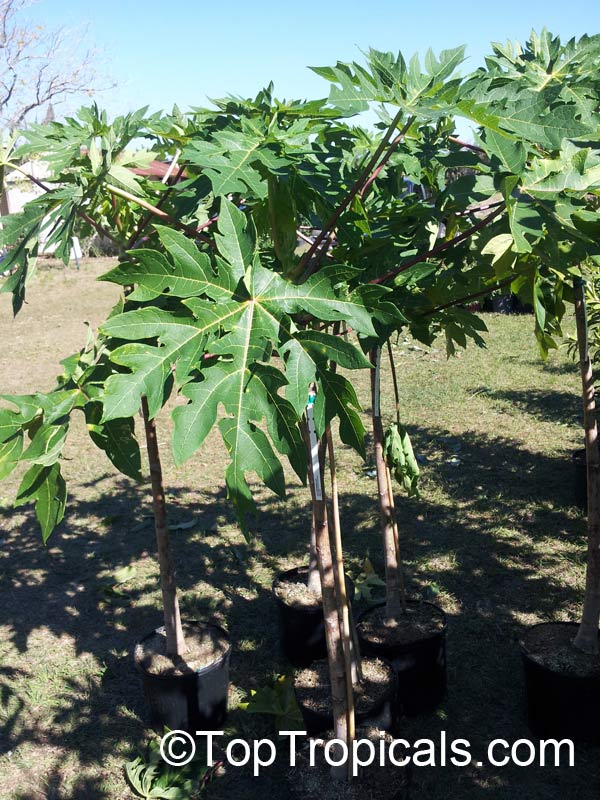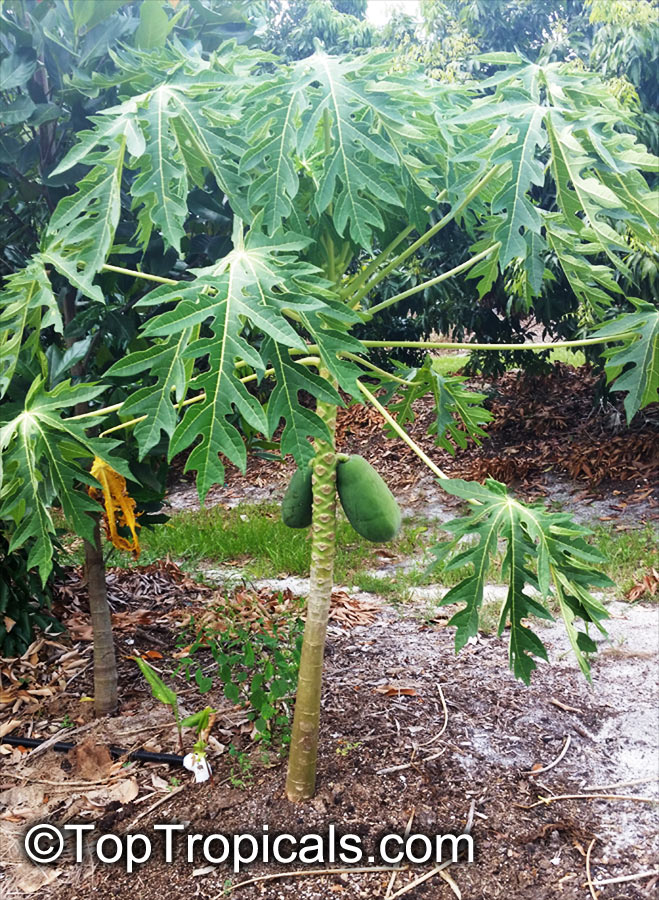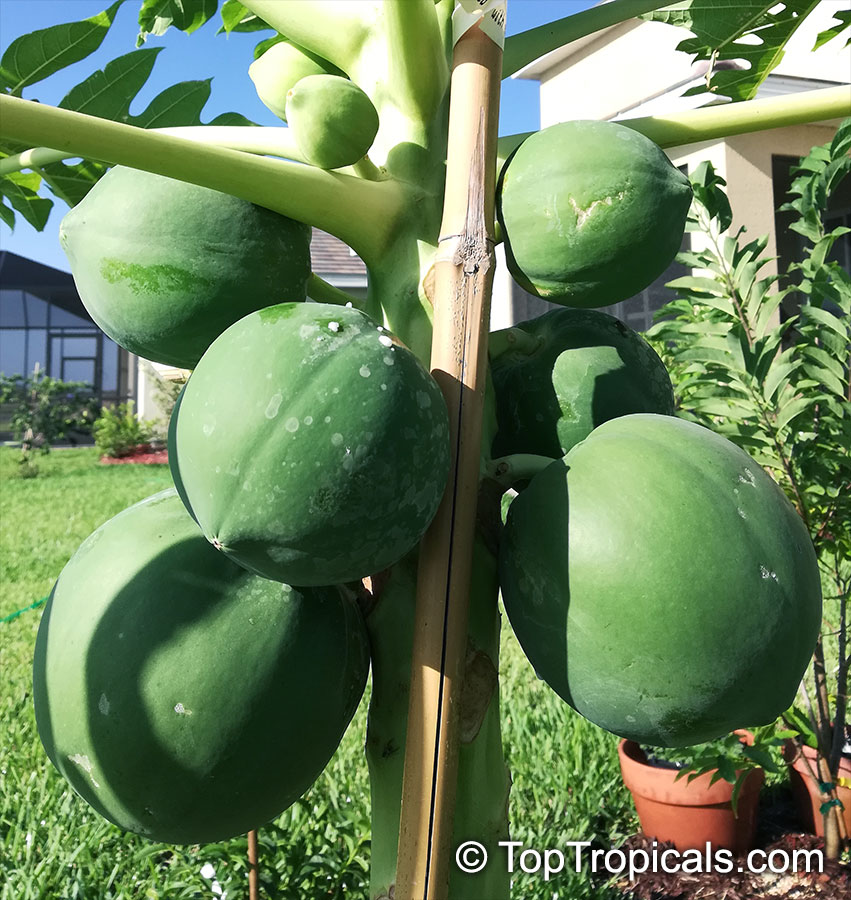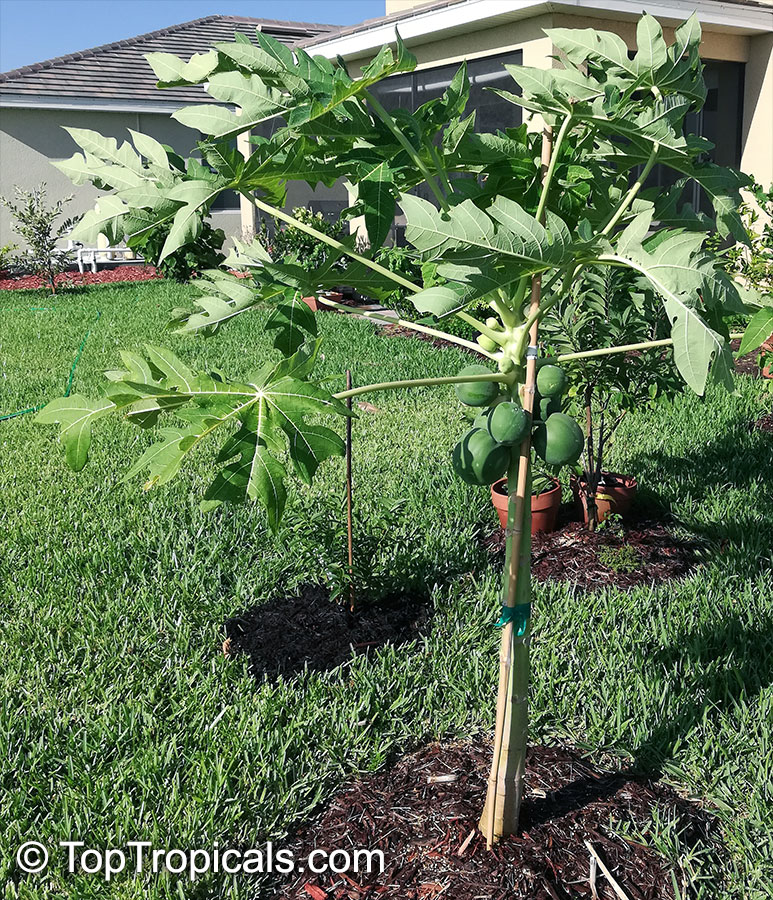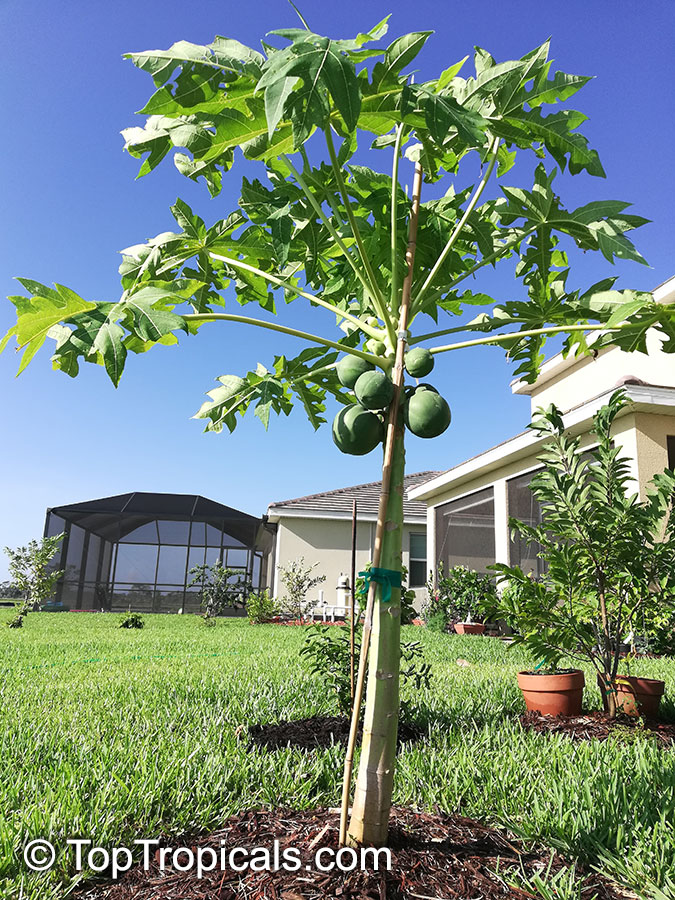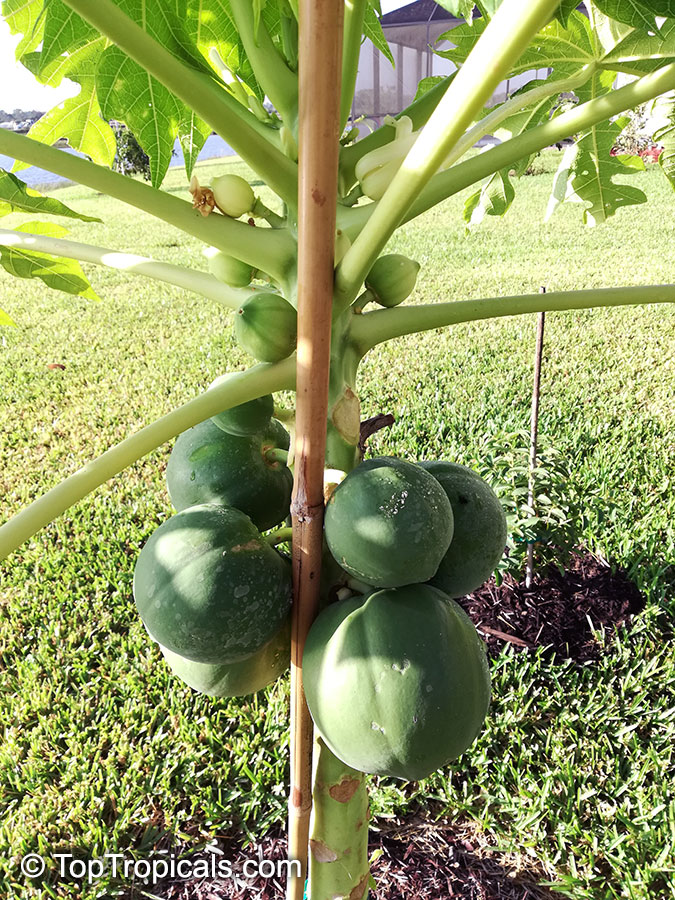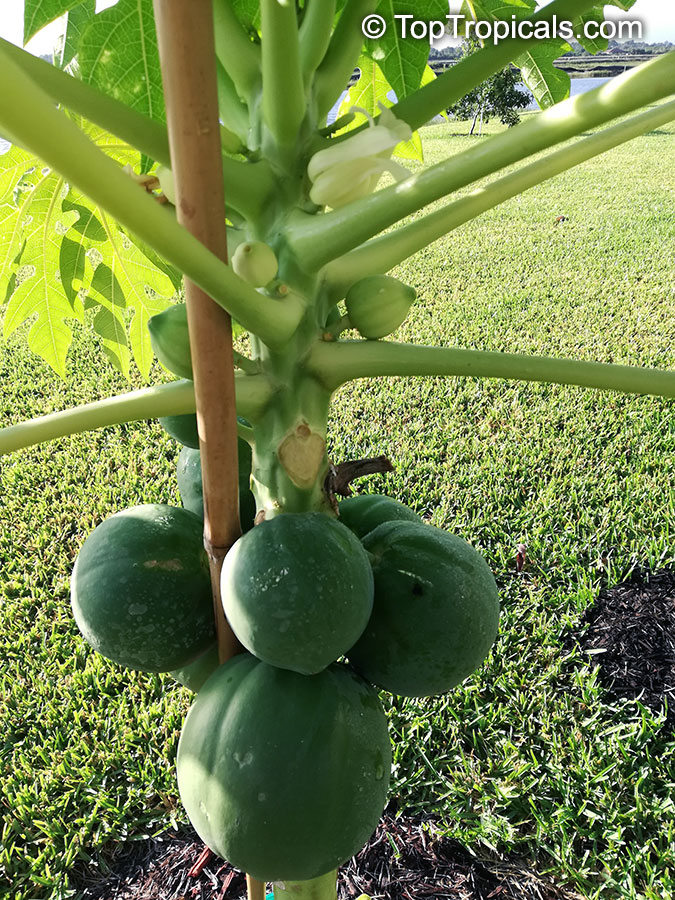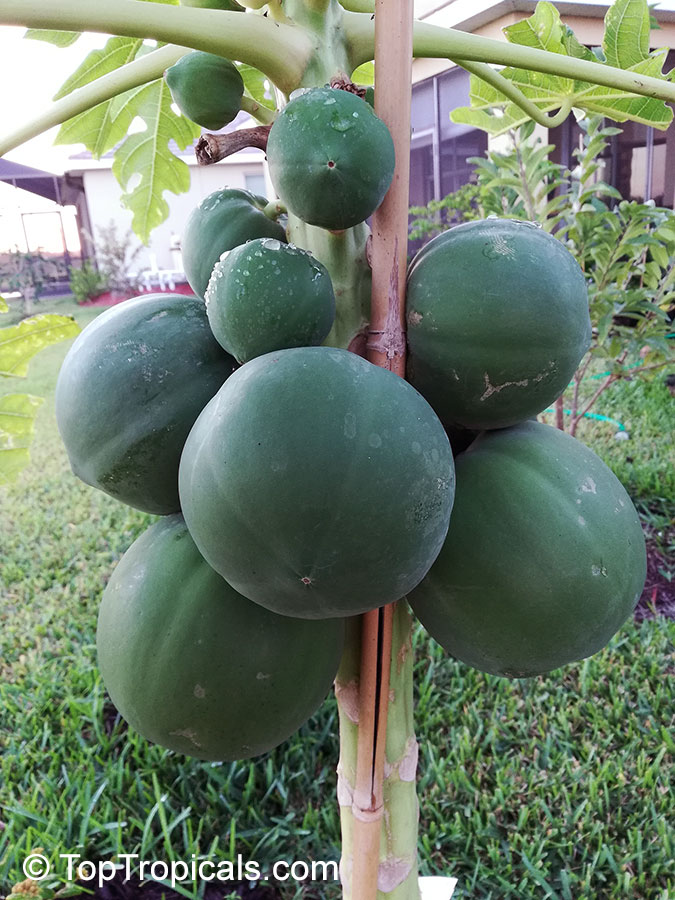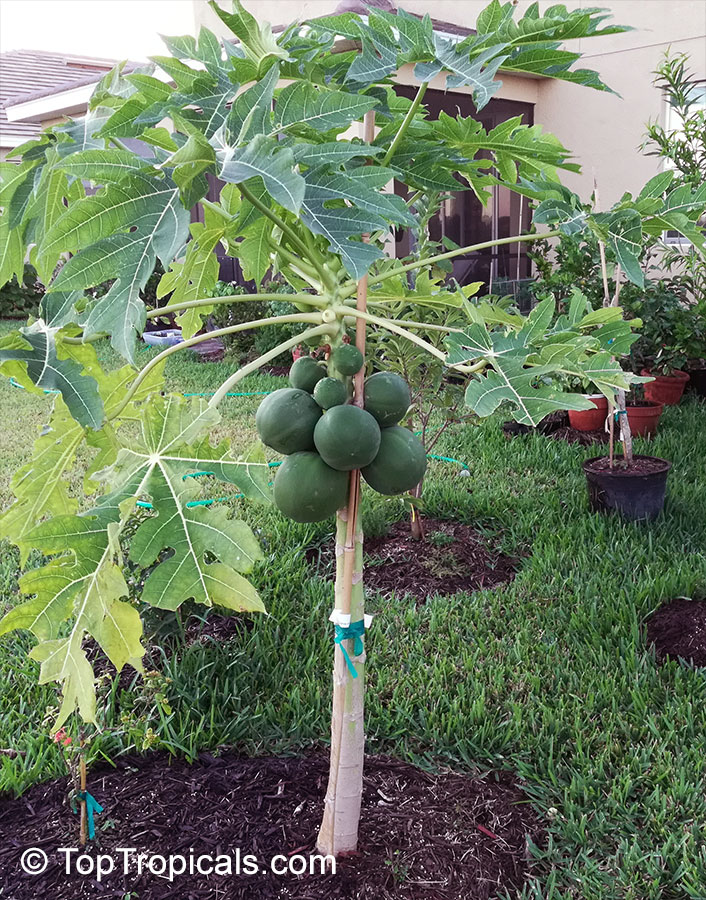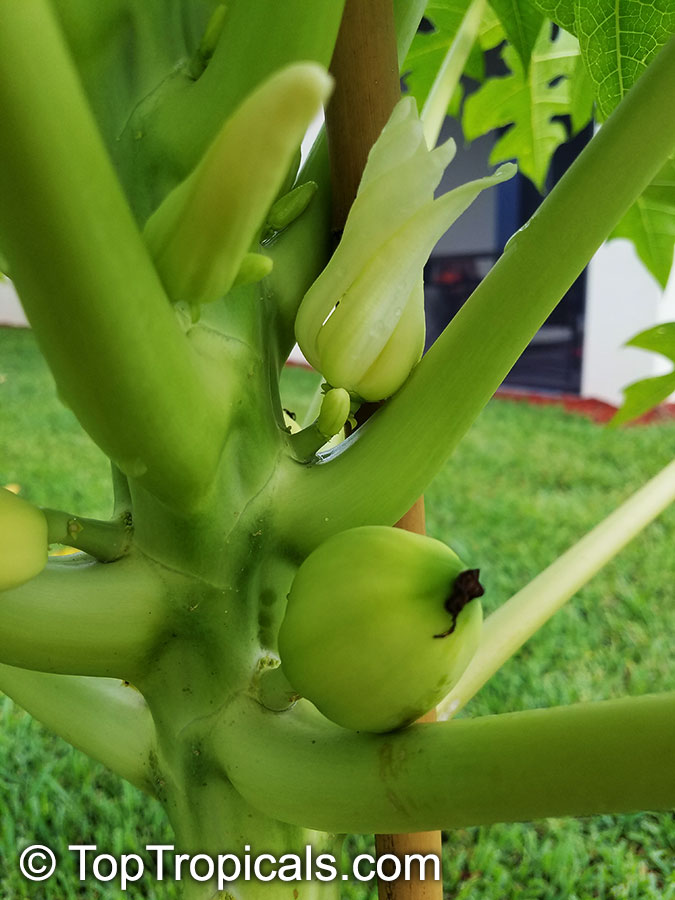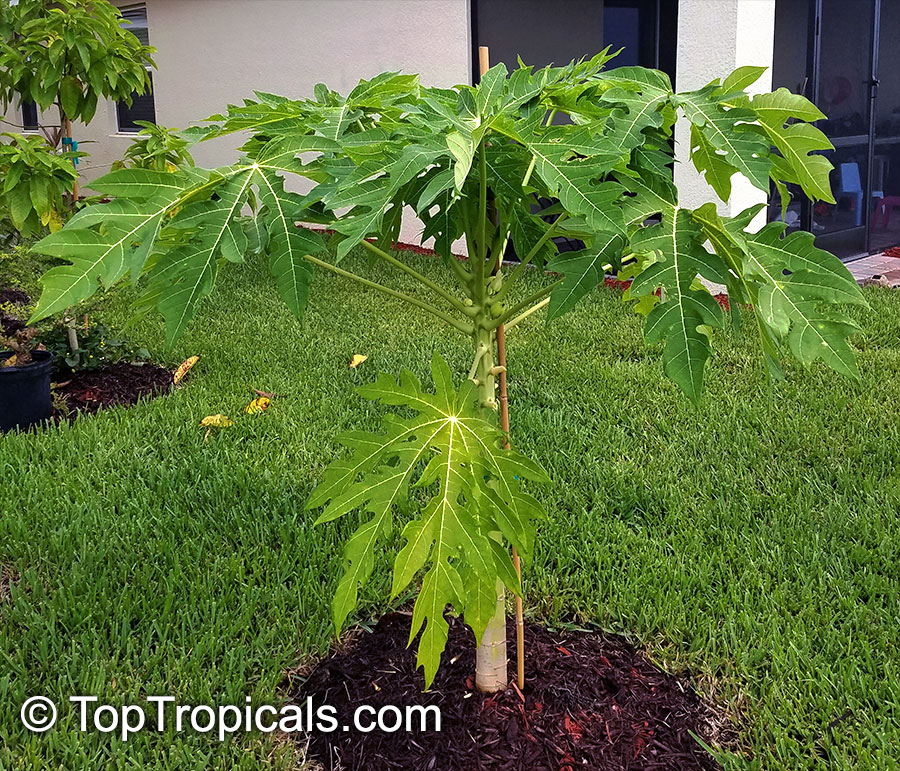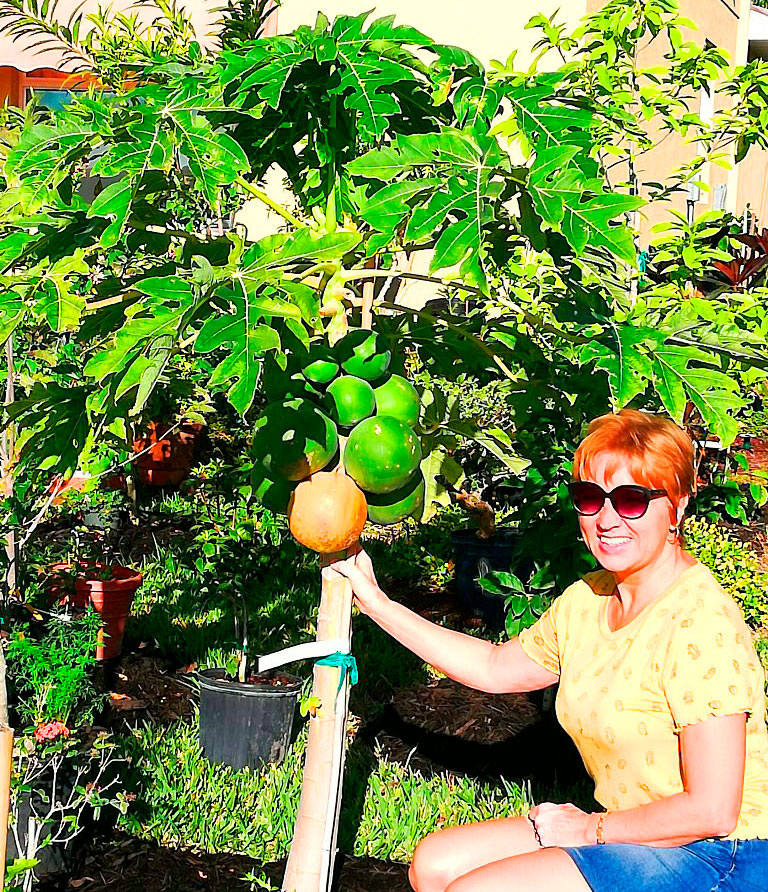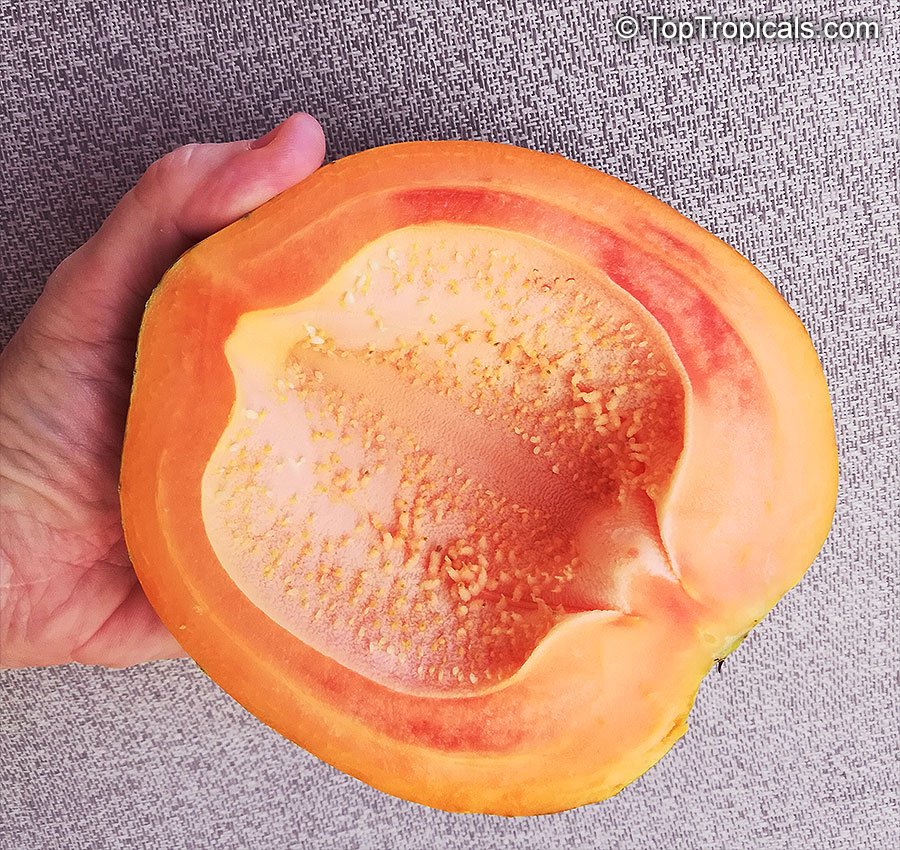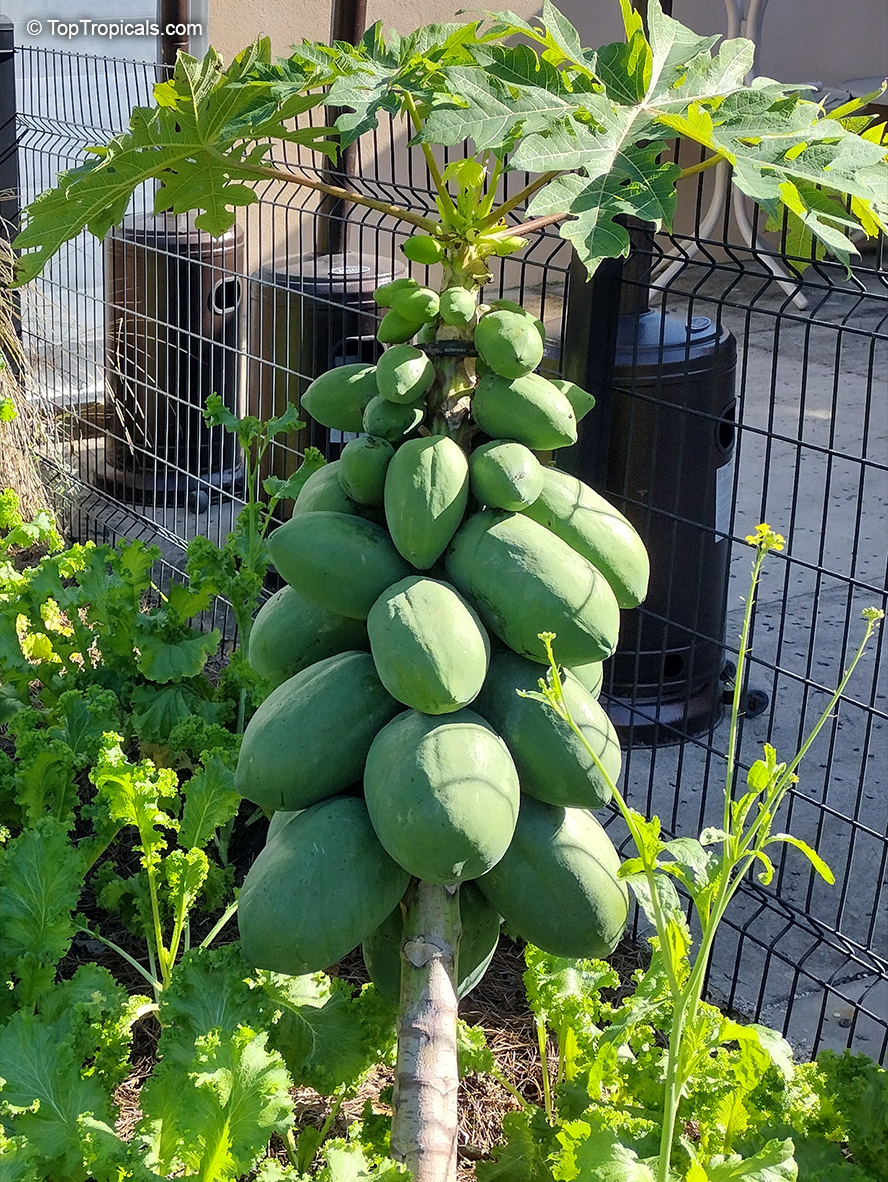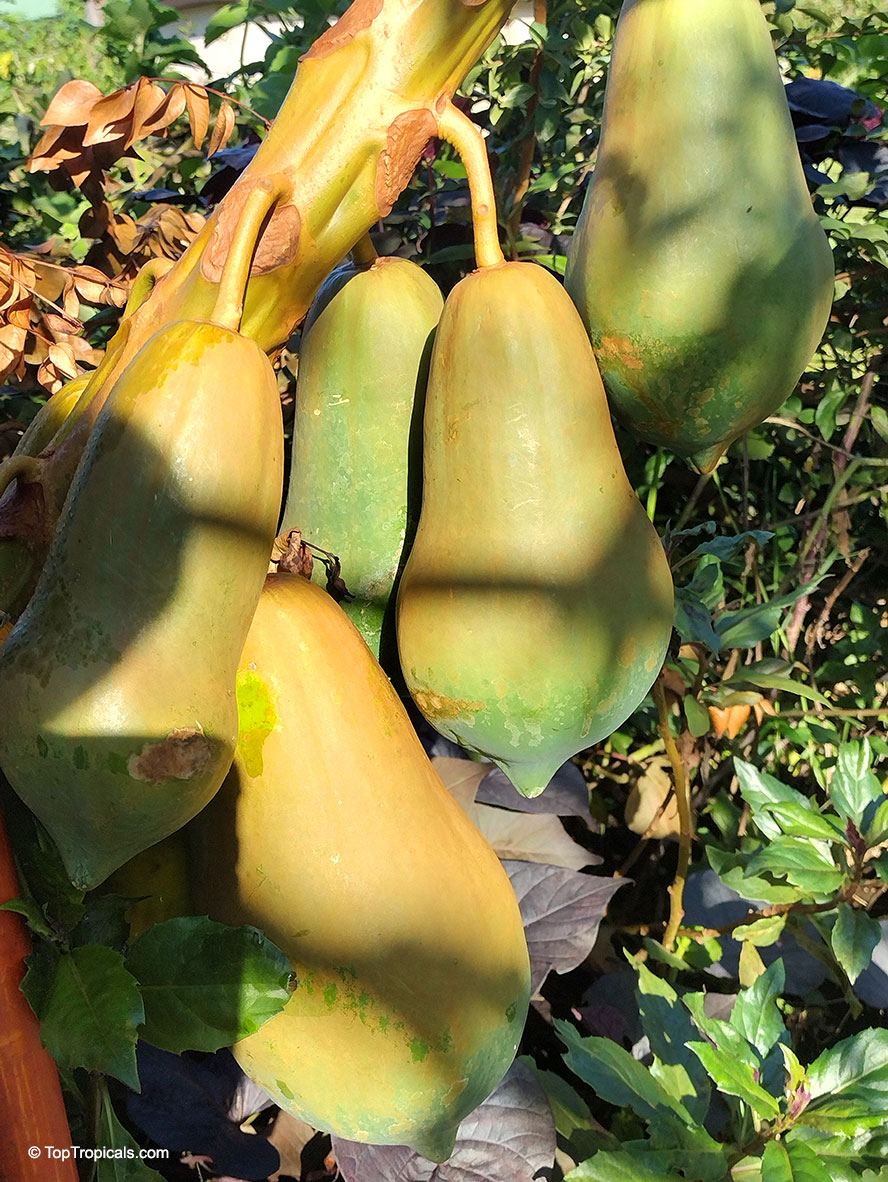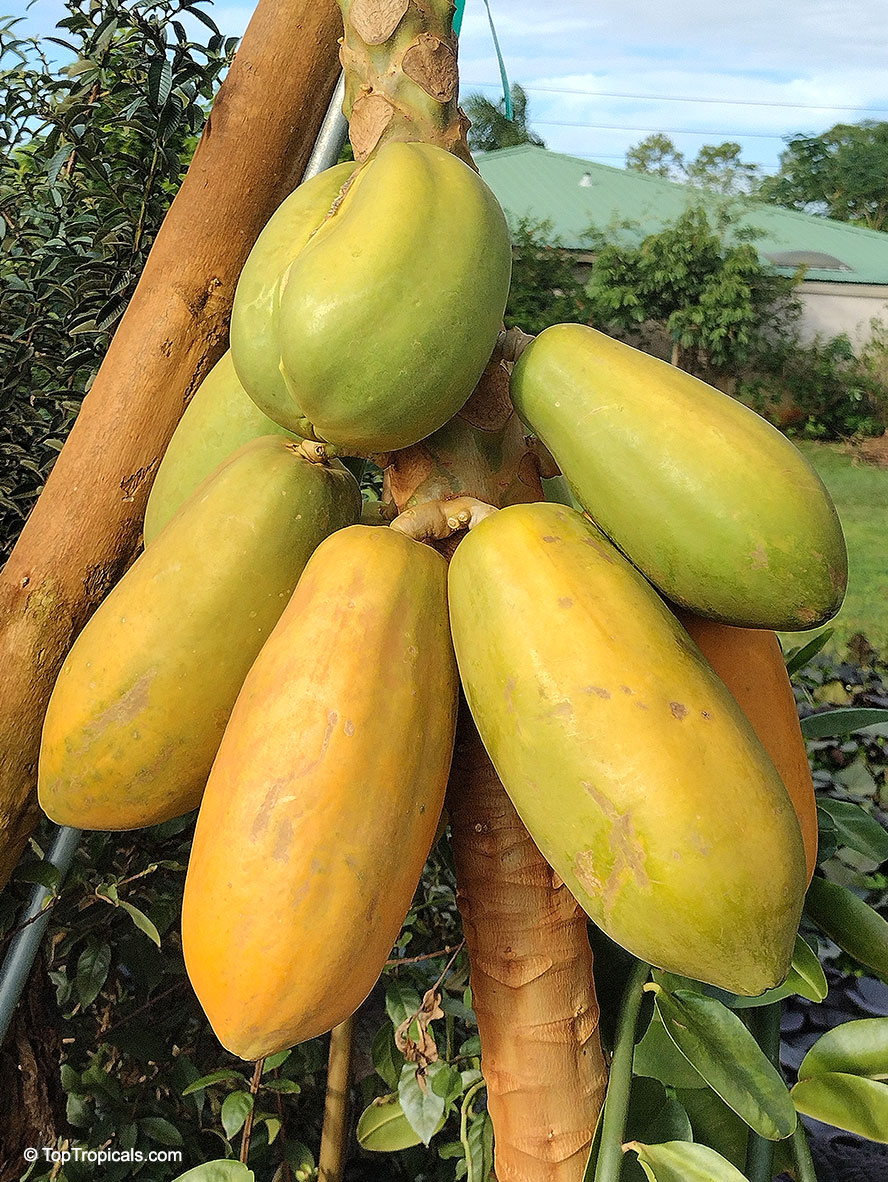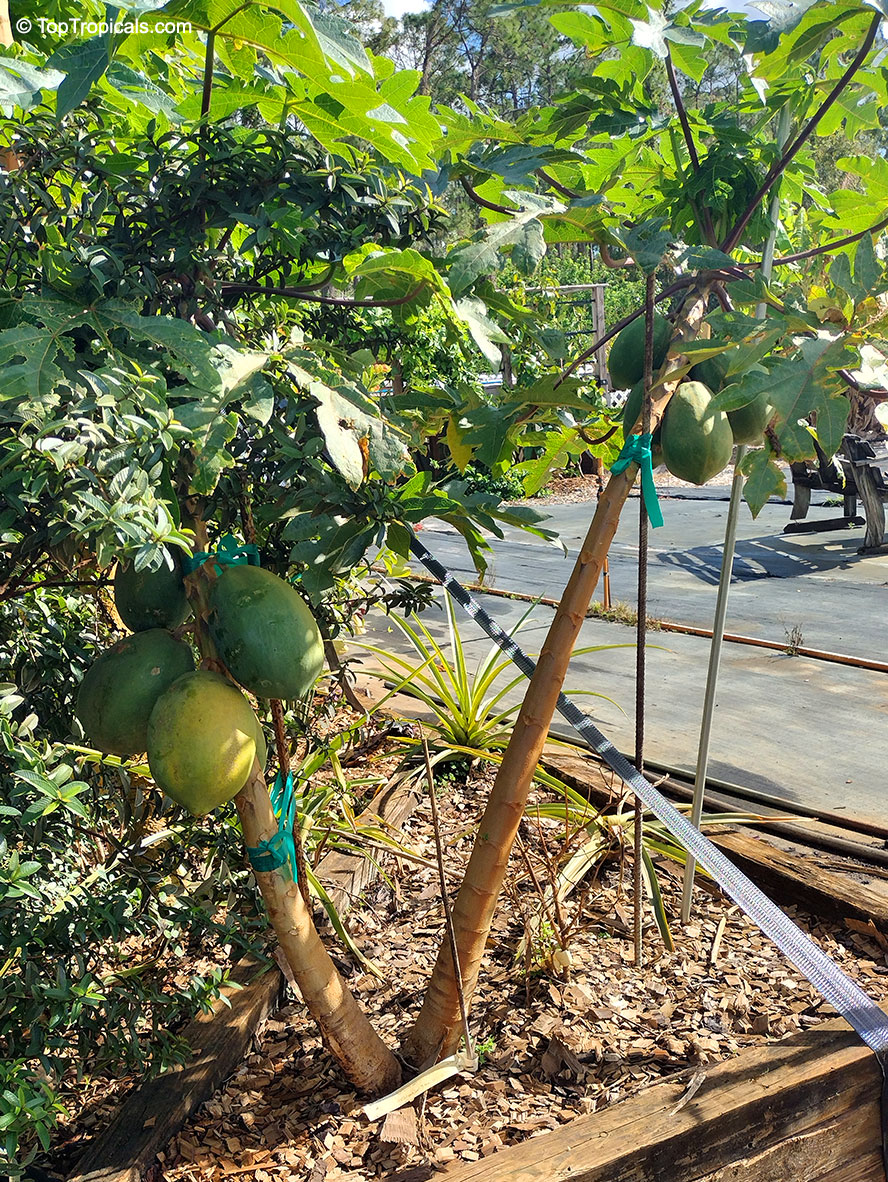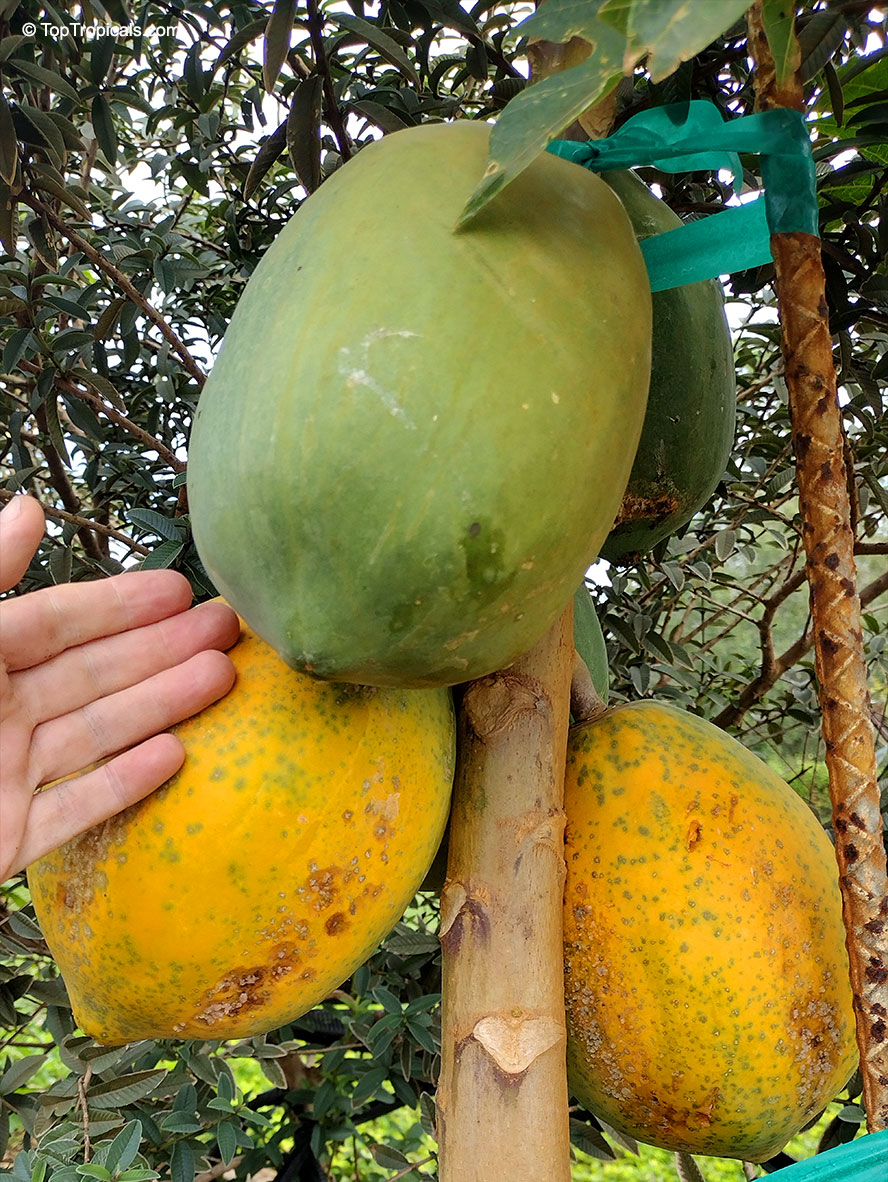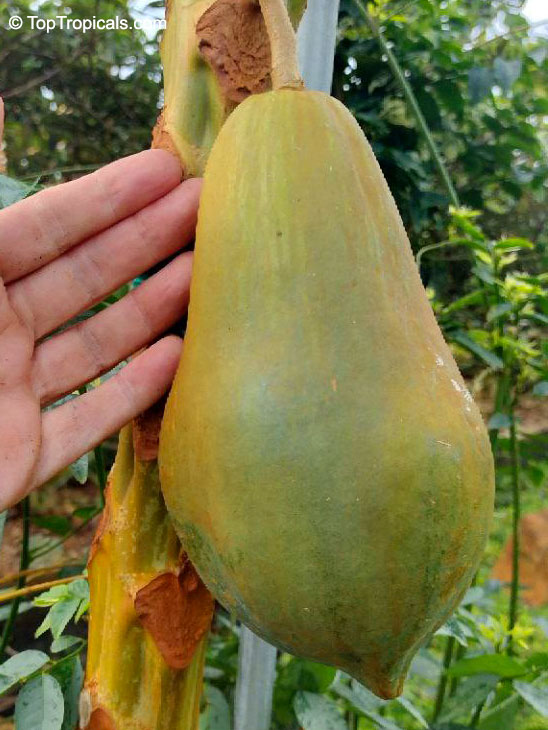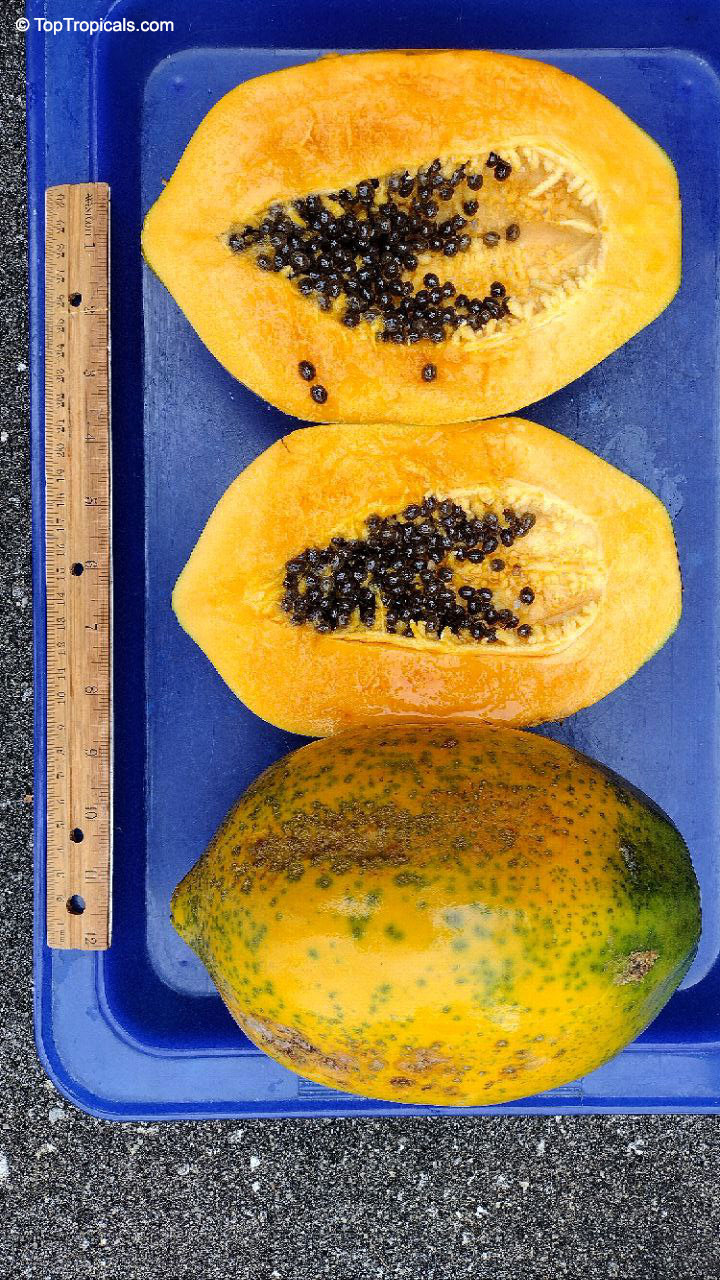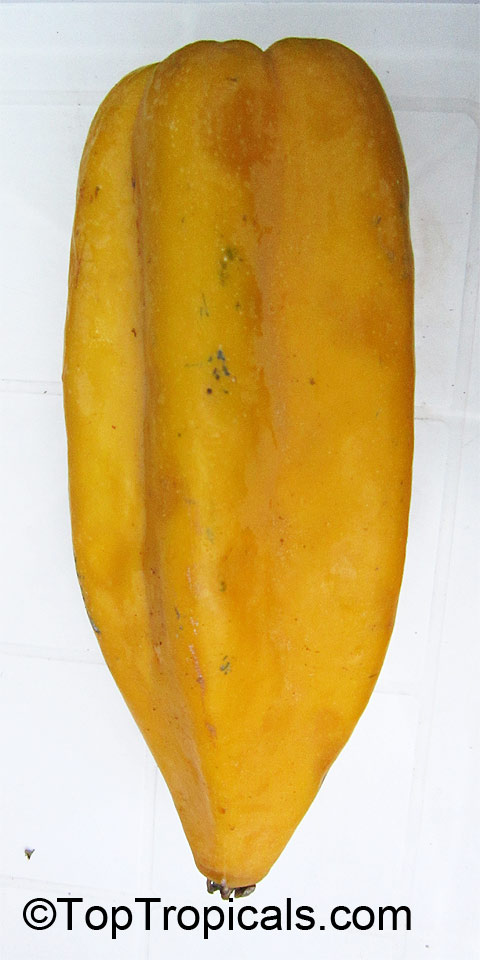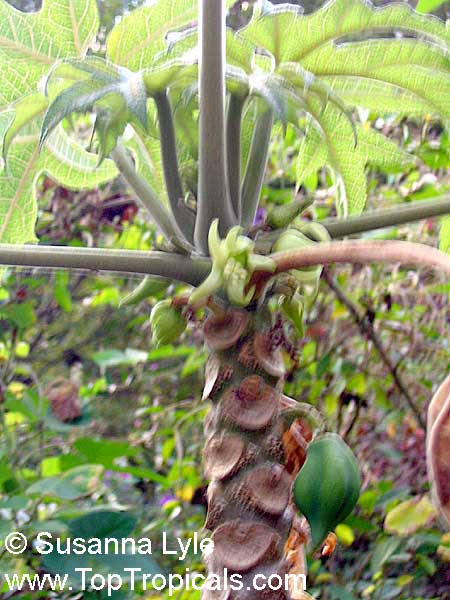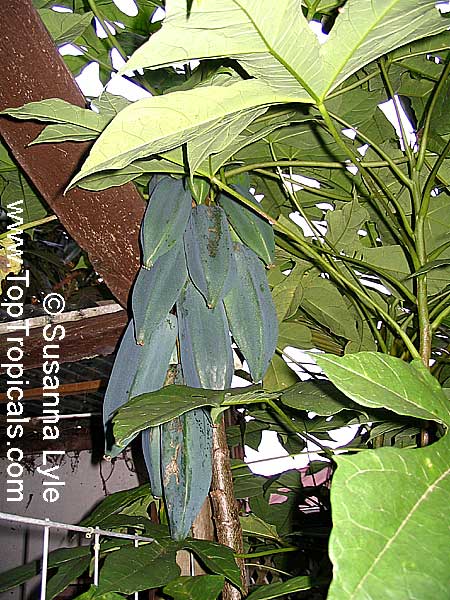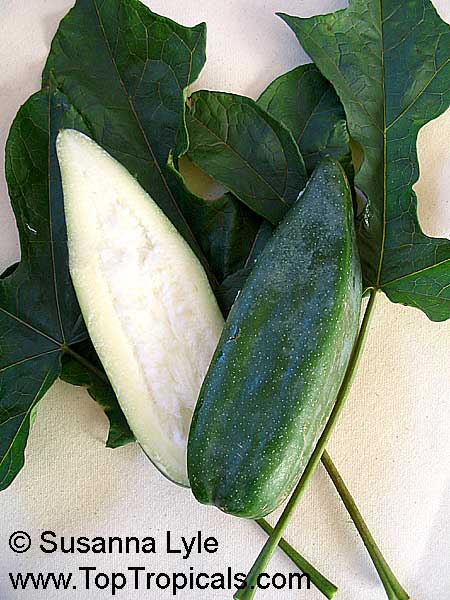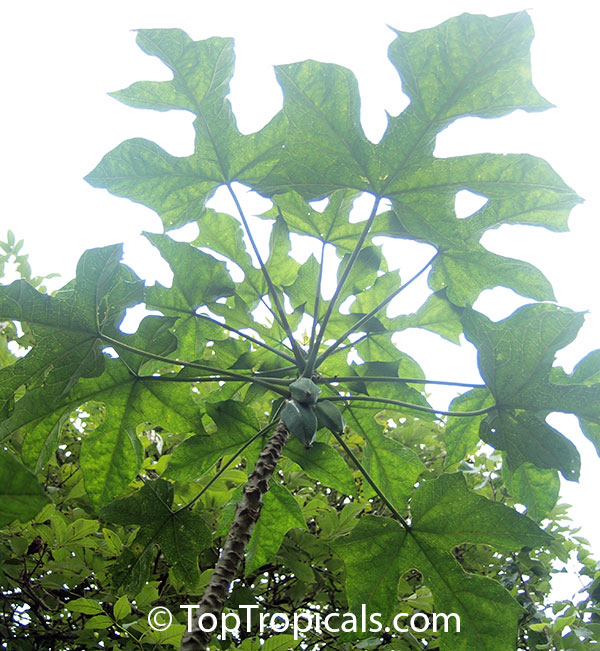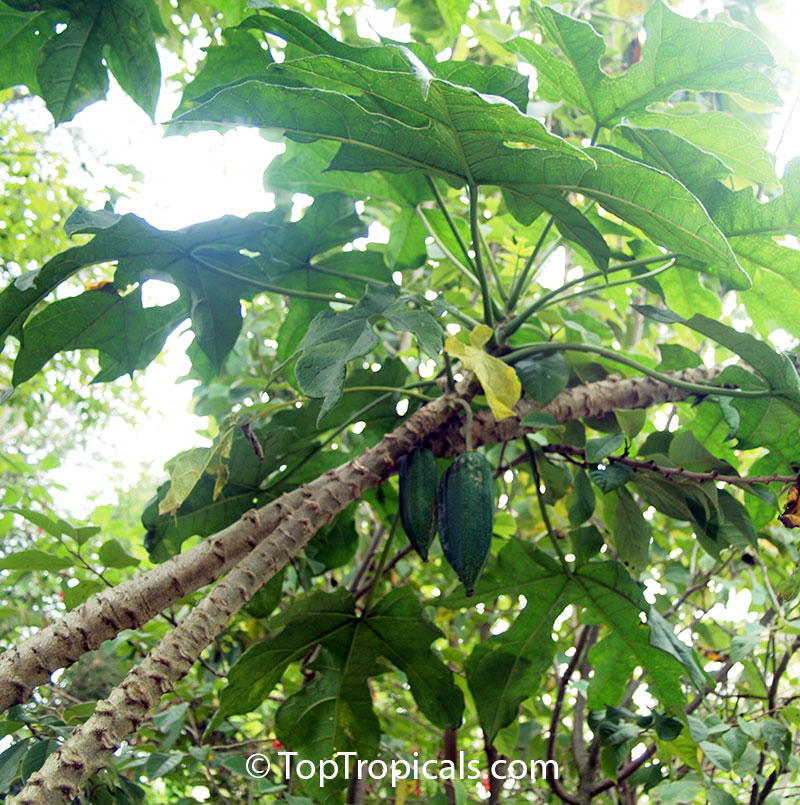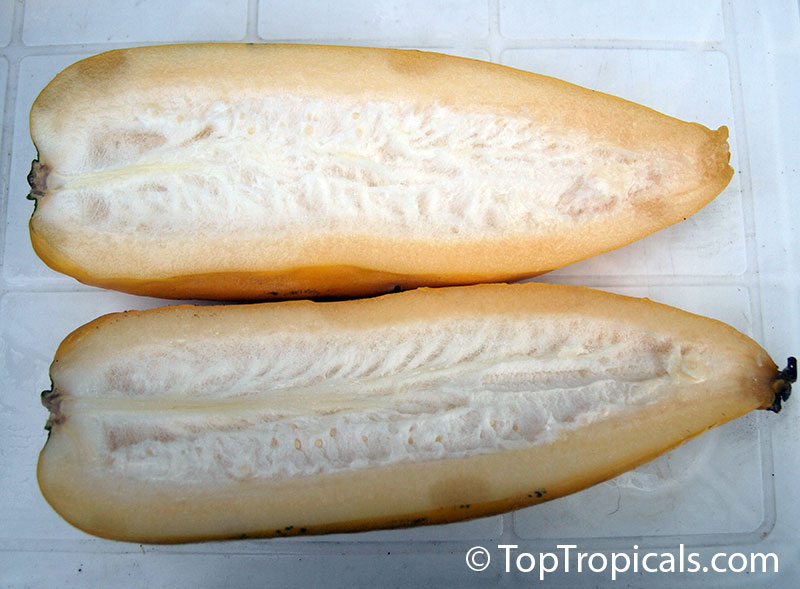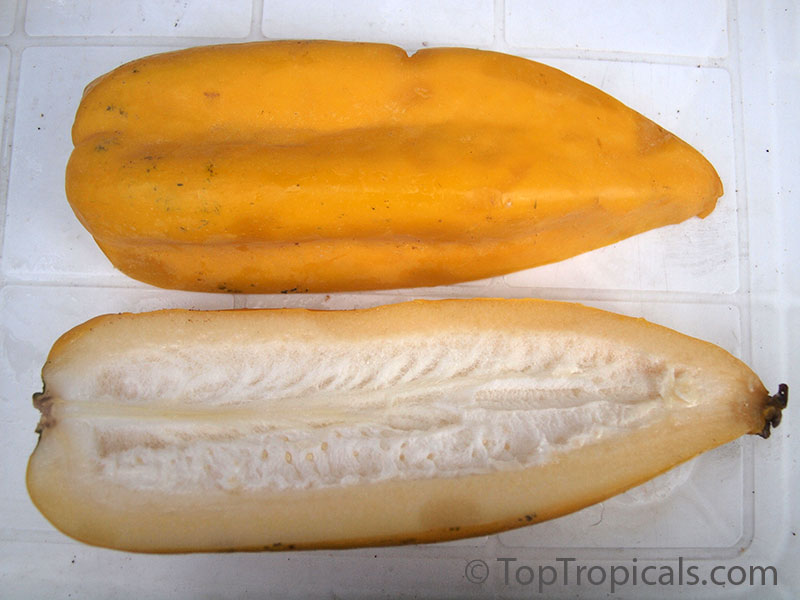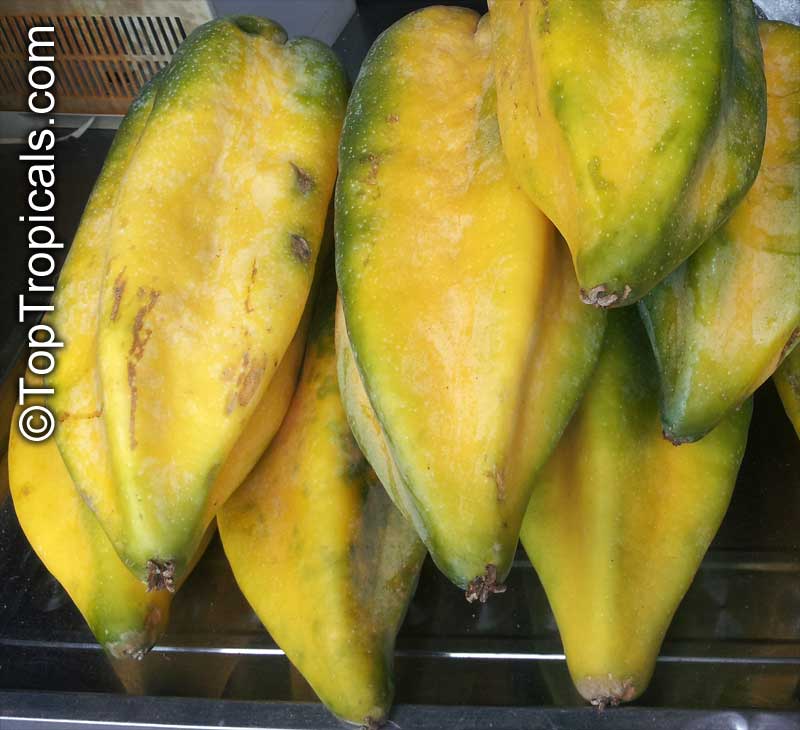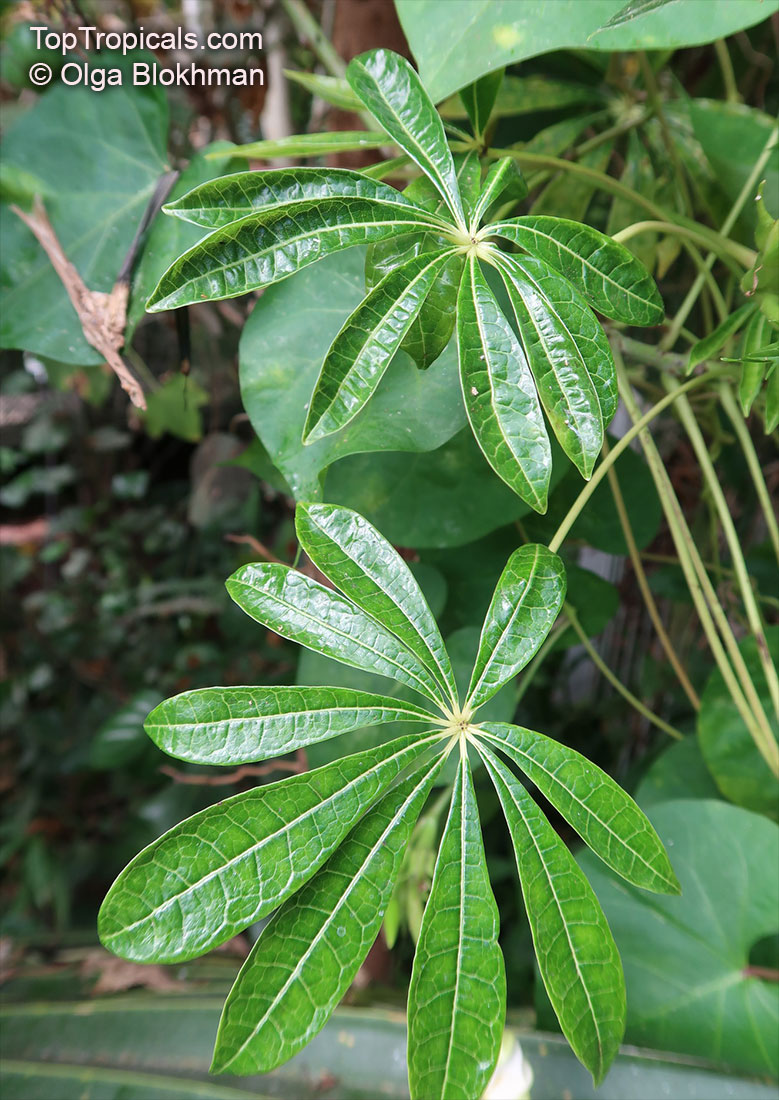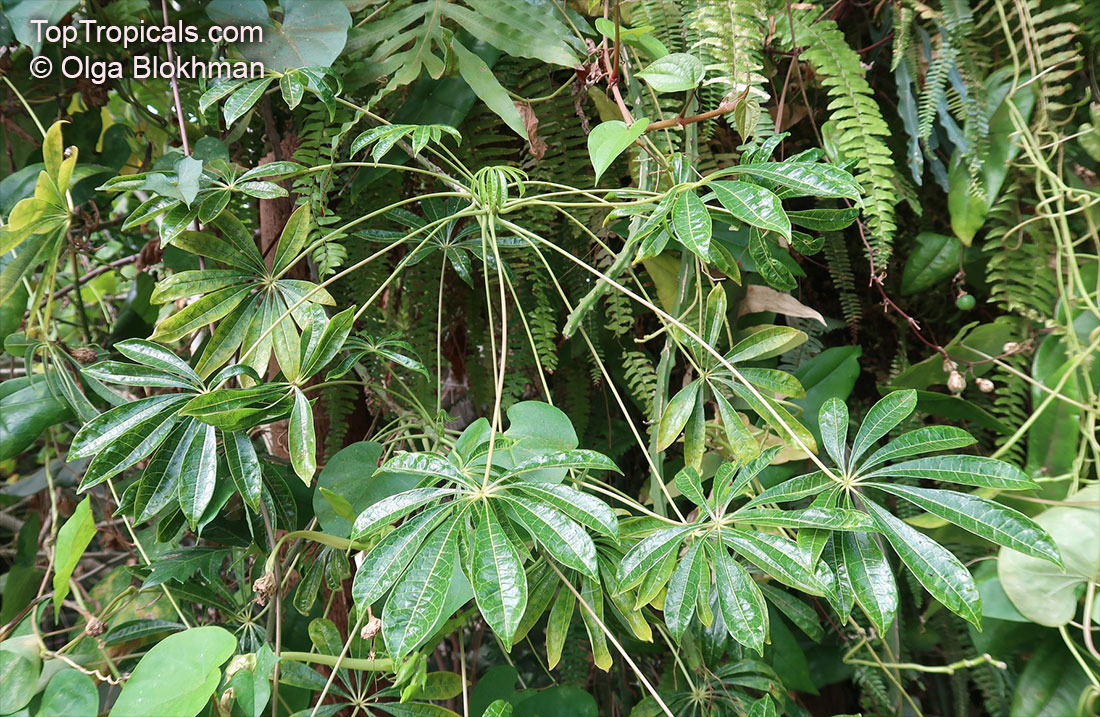Caricaceae - Botanical Family
Top Tropicals Plant Encyclopedia
| Number of plants found: 4 |
Botanical name: Carica papaya
Common name: Papaya
Family: Caricaceae
Origin: Tropical America









Papaya is one of the fastest fruiting plants to grow. Often starting production the same year from planting a seed, papayas are ideal for gardeners seeking quick rewards. Many dwarf varieties reach only 6-8 feet tall, yet produce large crops of full-sized fruit that are easy to harvest. Papaya trees are space-efficient, making it possible to plant multiple trees in even small gardens. Plant 2-3 different cultivars to enjoy year-round harvests of healthy, delicious fruit.
Papaya is a fast growing herbaceous plant with thick, hollow trunk. Leaves lobed to 2' across. Flowers/fruit appear in nodes directly from trunk. Fruit size varies from 1/2 to 20 pounds. Flesh is yellow to orange-red, melon-like. The tree may freeeze at about 31F, young plants are very tender. Plant in full sun, however it grows tall in shade, but produces less fruit. Best to use lots of organic matter and mulch to reduce nematode problems. Best to replant every 4-5 years, although trees live and produce to up to 30 years, but the best fruit quality comes from younger trees. Soil must be well-drained. The delicious fruit of the papaya is good for you as a dessert or as a digestive aid (it contains the enzyme papain, which is essential to digestion). Papaya flowers can be male, female, or hermaphrodite. Solo Papayas are self pollinating.
When starting a plant from seed, first wash the seeds well and remove the slippery outer coating; then sow immediately. Cover with soil and keep in a warm, bright place. Germination should occur in four to eight weeks. Papayas are prone to damping-off. Water copiously in the summer but less frequently in the winter. When repotting, do not disturb root system. Papaya roots are very sensitive for transplanting.
Fun facts about Papaya:
Not a tree: Papaya is technically a giant herb with a single, straight trunk that can grow up to 30 feet tall.
Gender flexible: Papaya plants can change their gender based on environmental conditions. This complex mechanism ensures better adaptability.
Cold and wind resistant: Papayas can withstand light freezes and strong winds, making them surprisingly hardy for a tropical plant.
Solo cultivars: These smaller, round or oval papayas are incredibly sweet and less susceptible to fruit flies.
Learn more: How to grow a Papaya Tree: Practical Guide
Shipped at customers risk, no replacements or refunds. Leaf drop possible. We guarantee healthy plant to be shipped and the best packaging. Express shipping optional.
Recommended Fertilizer: SUNSHINE C-Cibus - Crop Nutrition Booster
SUNSHINE-Honey - sugar booster
Ordering seeds info
RECOMMENDED SUPPLIES:
Seed Germination Mix #3, professional grade
SUNSHINE-Epi - Seeds and cuttings booster
SUNSHINE Bombino - Young Plant Booster
Ordering seeds info
RECOMMENDED SUPPLIES:
Seed Germination Mix #3, professional grade
SUNSHINE-Epi - Seeds and cuttings booster
SUNSHINE Bombino - Young Plant Booster
Shipped at customers risk, no replacements or refunds. Leaf drop possible. We guarantee healthy plant to be shipped and the best packaging. Express shipping optional.
Recommended Fertilizer: SUNSHINE C-Cibus - Crop Nutrition Booster
SUNSHINE-Honey - sugar booster
Shipped at customers risk, no replacements or refunds. Leaf drop possible. We guarantee healthy plant to be shipped and the best packaging. Express shipping optional.
Recommended Fertilizer: SUNSHINE C-Cibus - Crop Nutrition Booster
SUNSHINE-Honey - sugar booster
Botanical name: Carica papaya
Common name: Dwarf Papaya
Cultivar: Dwarf
Family: Caricaceae








Carica papaya is a fast growing herbaceous plant with thick, hollow trunk. Leaves lobed to 2' across. Flowers/fruit appear in nodes directly from trunk. Size varies from 1/2 to 20 pounds. Flesh is yellow to orange-red, melon-like.
Dwarf papayas are fruit-bearing trees that grow to heights of less than 10 feet. In fact, many varieties stop at between 3 and 5 feet.
They grow smaller, making them ideal for small gardens, pots, or containers.
Fruits are closer to the ground, so you can pick them without climbing or special tools.
Dwarf papayas often produce fruit faster than taller varieties. Despite their size, they produce a lot of fruit.
Perfect for urban areas or where space is limited.
Easier to care for and manage compared to larger trees.
Learn more: How to grow a Papaya Tree: Practical Guide
Shipped at customers risk, no replacements or refunds. Leaf drop possible. We guarantee healthy plant to be shipped and the best packaging. Express shipping optional.
Recommended Fertilizer: SUNSHINE C-Cibus - Crop Nutrition Booster
SUNSHINE-Honey - sugar booster
Shipped at customers risk, no replacements or refunds. Leaf drop possible. We guarantee healthy plant to be shipped and the best packaging. Express shipping optional.
Recommended Fertilizer: SUNSHINE C-Cibus - Crop Nutrition Booster
SUNSHINE-Honey - sugar booster
Shipped at customers risk, no replacements or refunds. Leaf drop possible. We guarantee healthy plant to be shipped and the best packaging. Express shipping optional.
Recommended Fertilizer: SUNSHINE C-Cibus - Crop Nutrition Booster
SUNSHINE-Honey - sugar booster
See picture of a mature fruiting tree 6 ft tall
This item is certified for shipping to all states/territories, excluding: California, Texas, Louisiana, Hawaii, Puerto Rico, US Virgin Islands, Arizona More infoBotanical name: Carica pentagona
Common names: Champagne Fruit, Babaco
Family: Caricaceae
Origin: Tropical America





This attractive torpedo shaped fruit has an effervescent flesh hence its other name the Champagne fruit. The texture of the golden fruit is light and refreshing. The slightly acid flavor has a hint of strawberry, pineapple and pawpaw and can be made into a tasty thirst quenching drink. The unripe green fruit is delicious used as a green vegetable in curries and chutney. A very close relative of Carica papaya,
the babaco needs fertile well-drained soil and warm conditions to grow well.
Botanical names: Jacaratia spinosa, Carica spinosa
Common names: Wild Mango, Mamoeiro-bravo
Family: Caricaceae
Origin: South America







Jacaratia spinosa is a small to medium-sized deciduous tree with a very striking, strange, yet attractive appearance that is native to South America. Also known as Wild Mango, the tree can reach up to 10 to 20 feet in height and is recognized for its ethnomedical properties. Depending on its location, the plant can be very thorny or spiny and grows best in full sun or semi-shade in areas with a USDA Zone of 9-11.
The most beneficial feature of a Jacaratia spinosa is its production of edible fruit, which has a particularly unique taste that is likened to chestnuts. The skin of the fruit is hard and needs to be scored and cooked before eating in order to take advantage of its high nutritional content and avoid the copious latex that is released. The edible fruit is rich in vitamins and minerals, making it an important and beneficial source of dietary nutrition. A fully mature Jacaratia spinosa can produce up to 25 fruits per season, making it a great addition to any home orchard or garden.
To ensure the best growth and care of a Jacaratia spinosa, special attention to soil and water requirements should be taken. The tree prefers the soil to be well-draining, loose, and slightly acidic in nature. Depending on its location, the amount of water that it needs will vary. In cold regions, the plant should be grown in a pot and placed close to a south-facing wall in order to supply the necessary amount of sunlight. Through this combination of environmental conditions, a Jacaratia spinosa can be cultivated with relative ease, thus allowing for bountiful fruits and a beautiful ornamental addition to the garden!
Use link to repeat this search:
https://toptropicals.com/cgi-bin/garden_catalog/cat.cgi?search_op=and&keyword_op=and&language=e&family=Caricaceae&number=10
&no_change_lang=1&user=tt&sale=1&first=0
